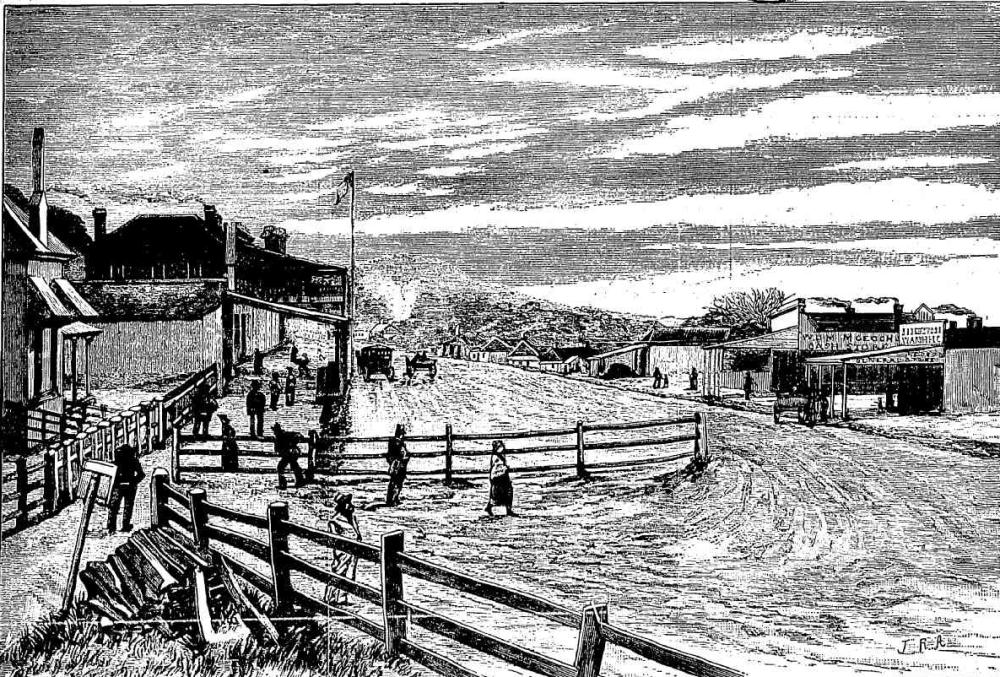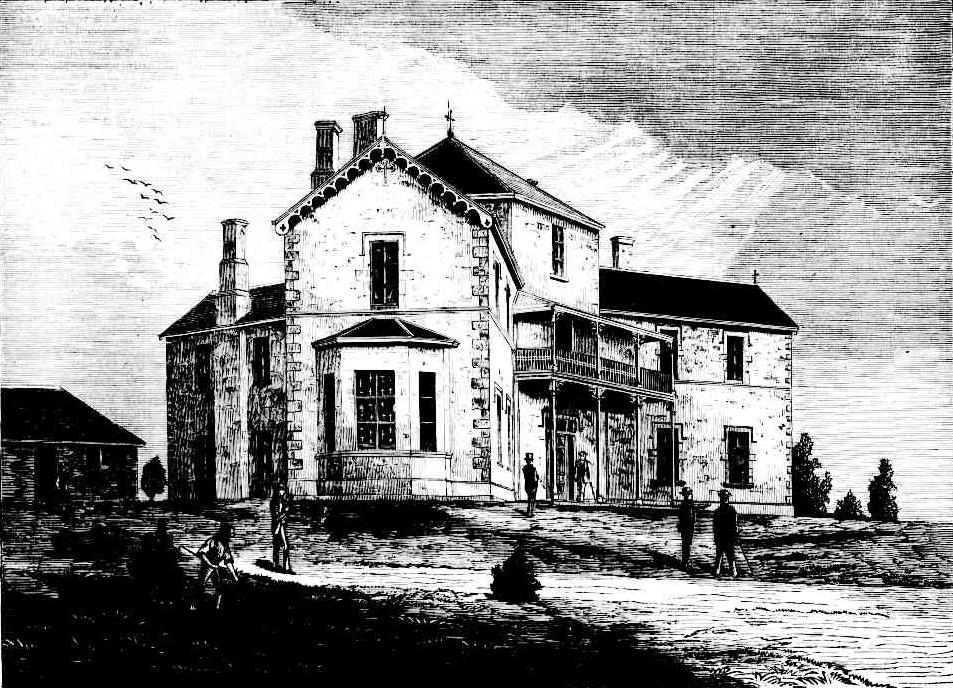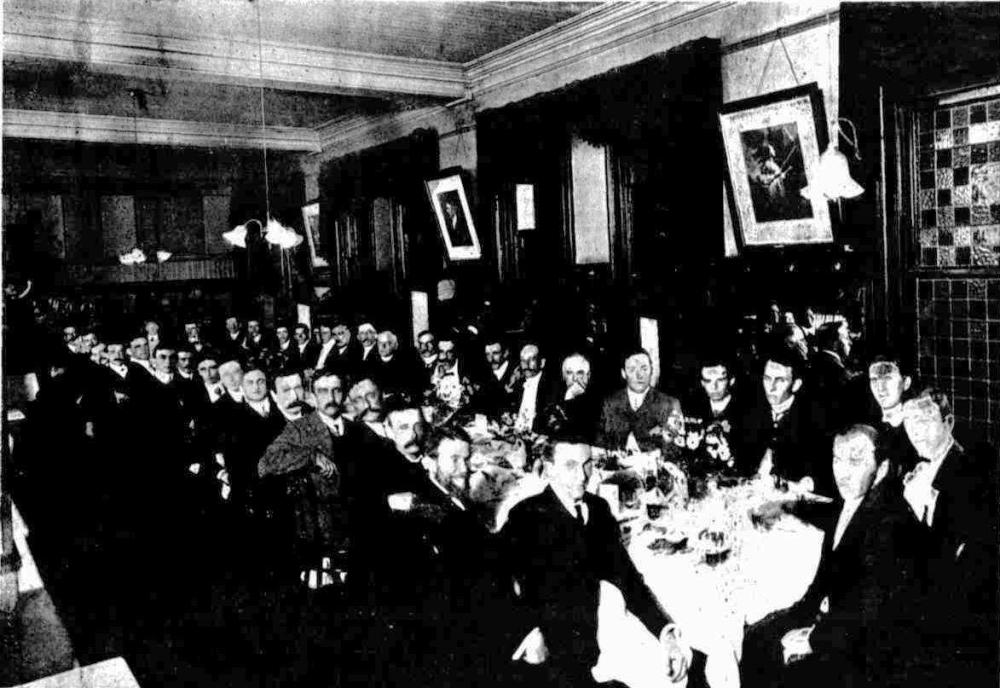A Premier Gynaecologist and Obstetrician and Hospital and Teaching Facility Builder
Herbert Schlink is noted among the attendees of the
March 1920 funeral of Sir Thomas Peter Anderson Stuart (1856-1920), professor of physiology and medical administrator, founder of the medical school at the University of Sydney, chairman of the Royal Prince Alfred Hospital (1901) under whom in 1904, the Victoria and Albert pavilions were built to flank G. A. Mansfield's central block.
Under Anderson Stuart, dean of medicine and fellow of the senate (1883-1920) the undergraduate enrolment in medicine rose from 6 to 604 and staff also increased substantially.
Biographer J. A Young states..' Drawing heavily on Edinburgh, his appointments—among whom were the foundation professors of anatomy (J. T. Wilson in 1890) and pathology (D. A. Welsh in 1902)—included several highly talented scientists: Wilson, (Sir) Almroth Wright and (Sir) Charles Martin, all of whom became fellows of the Royal Society (London). Anderson Stuart, known to the undergraduates as 'Andy', was an illuminating lecturer, 'plain, direct, concise', who took infinite pains preparing his blackboard diagrams and founded the Sydney University Medical Society to assist students.' [2].
This description sound alike how Dr, Schlink was later described by his students. These teachers were his teachers. To list all this gentleman achieved would take several volumes - a timeline of key notes shows someone with high energy, exhaustless pursuit and being involved in more than a few aspects of health and medical developments still prevalent today.
Department of Public Health.
Herbert Henry Schlink, Esq.. M.B., to be a Government Representative on the Board of Directors of the Royal Prince Alfred Hospital, vice. Dr. J. B. Nash, deceased. APPOINTMENTS. (
1925, July 24).
Government Gazette of the State of New South Wales (Sydney, NSW : 1901 - 2001), , p. 3276. Retrieved from
http://nla.gov.au/nla.news-article223014612
Dr. Schlink had a few inconsistencies, or was an old world gentleman, who despite being known for puffing away on a cigar, didn't think women should smoke and was against the US Prohibition (drinking alcohol):
Cigarette Smoking.
Effect on Women.
BOSTON (U.S.A.), October
Dr Herbert A Schlink of Sydney who is attending the clinical congress of the American College of Surgeons stated that girls and women in the United States were seriously injuring their beauty and health by excessive cigarette smoking. Women who smoked incessantly were becoming extremely nervous and neurotic and typical nerve subjects for hospitals and specialists. He added however that smoking and dunking in moderation would not affect women but it seemed that they smoked continuously because they had all day to do it. Dr Schlinck expressed himself strongly against prohibition, stating, "You cannot prohibit anything by law '.Cigarette Smoking. (1928, October 11). The Argus (Melbourne, Vic. : 1848 - 1957), , p. 7. Retrieved fromhttp://nla.gov.au/nla.news-article3962204
AUSTRALIAN DOCTORS IN AMERICA.
Sir George Syme, of Melbourne (on the right) and Dr. Herbert H. Schlink, of Sydney, who are attending a clinical congress of surgeons in Boston.Englishmen's Second Sydney Match-- --A Hundred Years Old To-morrow (1928, November 16). The Sun (Sydney, NSW : 1910 - 1954), , p. 24 (CRICKET-STUMPS). Retrieved from http://nla.gov.au/nla.news-article223249221
A WISE MAN ABROAD
Sydney Medico Looks Over Hospitals . AUSTRALIA IS UP-TO-DATE .
(By Our Special Correspondent, ISABEL RAMSAY)
PARIS, April 22, 1929.
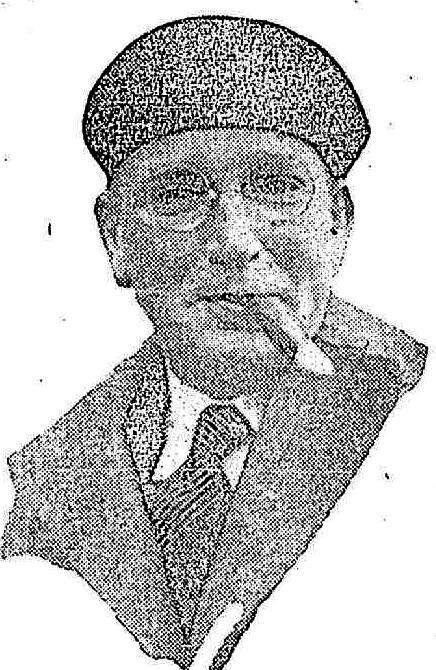 Dr. Herbert Schlink spent a few days in Paris last week on his way through to London. Since his arrival in Europe some five months ago, Dr. Schlink has wandered as far afield as Constantinople, to reach which he went through some amusing, though trying, experiences as a result of the Orient express being snow-bound.
Dr. Herbert Schlink spent a few days in Paris last week on his way through to London. Since his arrival in Europe some five months ago, Dr. Schlink has wandered as far afield as Constantinople, to reach which he went through some amusing, though trying, experiences as a result of the Orient express being snow-bound.In an informal chat I had with Dr. Schlink, he told me of that part of his trip which was occupied with things rather more serious than skiing and sight-seeing. Much of it was sufficiently interesting to tempt me to commit the indiscretion of divulging it in print.
THE FAMOUS BROTHERS.
Before coming to Europe, Dr. Schlink spent some the in the United States, during which he visited over 74 hospitals and kindred institutions. Most famous of all, he visited the Mayo Institute at Rochester. His description of the gigantic scale on which this is organised, with sidelights on the details ol the working of it, together with the history of its foundation by the father of the two brothers who now run it, sounds more like a romance from the Arabian Nights than a recital of actual facts. All Rochester turns round the Mayo Institute, and its many ramifications. The entire activities of the town are centred in the running of the collection of hospitals and private clinics which are controlled by this amazing couple. There is one building of 17 stories, where only diagnoses are carried out. There is a staff of 168 paid doctors, and at least 10 'heads' who are responsible for the running of their own special department.
Philanthropy.
What appealed personally to Dr. Schlink, as it is a subject he is very interested in, was the arrangements made for the convenience of the middleclass patient, who, without being a pauper, has not the means at his disposal to pay the heavy fees demanded l-y private clinics. For these an arrangement is always made by the doctor in charge of the case, and accommodation found in the private rooms and small private wards attached to the big institutions.
Quite an innovation, though, is the hotel which has recently been built at Rochester, with the object of helping out the middle-class patient. There are many cases, particularly surgical ones, where it is not absolutely necessary for the patient to be in a hospital after a certain number of days, and yet where a certain amount of medical attention is still needed. In order, therefore, to lighten the burden of expense for the middle-class patient, this hotel .was built, and the four top floors of it reserved for people who arc still under medical supervision, people who, for instance, have to have dressings done once or twice a day, and nothing more. There is a staff: of nurses in attendance to continue to give these patients the attention they may need, and during the remaining hours of the day and evening they are free to move about the hotel, to mingle with the other guests, and listen to the orchestra or the radio in the Winter Garden. It is a system which has been found to prove most popular. The only drawback, according to Dr. Schlink, is from the point of view of the ordinary guests in the hotel, for they are apt to demur at times when they find themselves seated beside someone with his head swathed in rather grim-looking bandages, or another guest-patient smelling rather strongly of iodoform.
AMERICA'S LEAD.
ALL through the United States, Dr. .Schlink was impressed with the consideration that is being given to the patient with a moderate income. At the New York Medical Centre, which is run in conjunction with the Columbia University, a whole wing has been sot aside for paying patients. At the Jewish Hospital at Brooklyn, which takes about six hundred patients, only one-third of these Are non-paying, the remainder being accommodated in paying wards of one, two, three, and six beds. In England, too, Dr. Schlink found this idea taking on tremendously. Thanks to such a system, very often the man of modest means is able to get the benefit of a better equipped operating theatre and X-ray department, combined with expert nursing, than the millionaire, capable of paying the heavy fees, demanded by the private clinics.
From Paris, Dr. Schlink went across to London, where he visited a number of the leading specialists and inspected several of the big institutions, including the cancer hospital. He is returning to Paris this week, and from here will go to Marseilles to catch his boat for home. This will be the Dutch boat, 'Slamat,' as Dr. Schlink intends taking in Java en route. At Batavia, he intends changing over to the 'New Zeeland,' of the Dutch Packet line, arriving in Sydney about June. Among the multiple impressions Dr. Schlink is taking back with him is the conviction that Australia has very little to learn as regards public hospitals and medical work generally. If anything, he is of the opinion that the members of the medical profession in Australia show a greater amount of sincerity and earnestness to their work than do the majority of medical men in other countries. A WISE MAN ABROAD (
1929, June 9).
Sunday Times (Sydney, NSW : 1895 - 1930), , p. 29. Retrieved from
http://nla.gov.au/nla.news-article131635858
SUNBURN. DANGER OF CANCER. WARNING ISSUED.
Canberra Conference. CANBERRA, Friday.
The Cancer Conference today agreed to a resolution which emphasised the danger of cancerous conditions following skin irritations caused by sunburn.
The resolution, which was moved by Dr. E. H. Molesworth, of Sydney, was as follows:
That this conference is impressed by the influence of skin irritation by sunburn as a potent factor in the production of precancerous conditions and actual cancer on exposed parts of the surface of the body, and considers that a warning should be given by health departments and other authorities to the public to keep constantly in mind the necessity of taking reasonable step.to avoid unnecessary sunburn during both recreation and outdoor work, especially In the drier districts of the interor.
This morning there was a long discussion on gynaecological cancer, and papers were read by Dr. Leila Keatinge and Dr. Constance Darcy, of Sydney. Dr. H. H. Schlink and Dr. F. A Maguire, of Sydney, and Dr. Robert Fowler, of Melbourne, discussed the field of utility of radium x-rays and surgery in relation to certain cancerous conditions in women.
Discussion on the gynaecological aspects of cancer was carried on by Dr. E. H. Molesworth, who referred to the original scheme initiated at the time of the distribution of radium to various hospitals in Sydney, under which a co-operative system of testing fully the different methods of treatment had been arranged so that additional knowledge, slowly accumulated at each treatment centre, might be at once available for the benefit of othei centres. Dr. Darcy, Dr. H. M. Moran (Sydney), Dr. Maguire, Professor D. Welsh, of the Uni-versity of Sydney, Dr. F. Hone, Adelaide, and Dr. H. K. Portel, Sydney, contributed to the discussion.
The discussion was marked by a desire to ensure that the experience of each delegate was available for the benefit of all others. It was recognised that further exchange of experience was necessary, and the outcome was an arrangement for complete and more immediate exchanges of experience between the hospitals in the different cities.
A committee, which was already In existence for the consideration of the physical aspects of radium, was increased by the addition of two medical members, and was entrusted with the task of following developments in the treatment of cancer by high voltage X-ray apparatus and by the radium bomb.
ORGANISATION.
The conference expressed a unanimous desire that some Australian-wide organisation should be formed to deal with the cancer problem, and a committee of seven was appointed to consult with existing organisations with the object of drafting a scheme of Federal organ-isation to keep the public informed of and to co-ordinate different activities of the cam-paign. Hope was expressed that at an early date there would be formed in Victoria an active organisation for enlisting the interest of the public to keep the public informed of progress made, and to co-ordinate all activities in that State engaged in the campaign against cancer. .It was stated that Victoria was th»; only State that had not formed an active organisation of the kind.
"A COMPLETE SUCCESS."
The Director General of Health (Dr. Cumpston), who presided at the conference, said afterwards that it had been a complete suc-cess. The number of delegates had been larger than .at any previous conference, and it was gratifying that New Zealand had sent two delegates. These delegates had stated that they had profited greatly by the discussions, and their experiences in New Zealand wer« also welcomed by the Australian delegates. The feeling at -the conference had been that all present were greatly impressed with the result of the work done to investigate one of tin great causes of death. The people of Aus-tralia might be well assured from the standard of work presented and from the earnestness of the discussion that whatever was possible in the difficult field of cancer research was being done. SUNBURN. (
1933, March 4).
The Sydney Morning Herald (NSW : 1842 - 1954), , p. 13. Retrieved from
http://nla.gov.au/nla.news-article16961554
HOSPITAL PLAQUE
To Commemorate Name of Dr. H. J. Marks
To commemorate the name of Dr. Herbert J. Marks, who died some years ago, the vice-president of Royal Prince Alfred Hospital (Sir Samuel Hordern) this afternoon unveiled a plaque of Dr. Marks, designed by Mr. Rayner Hoff, Dr. Sinclair Gillies paid a glowing tribute to his late friend and colleague, whom he described as a man with friends from peerage to the newsboy. It was decided to utilise the balance of the fund in research in connection with the ear, nose and throat. Memorial Plaque At R.P.A. Hospital.
Unveiling of memorial plaque to the tale Dr. H. J. Marks. From left: Dr. Sinclair Gillies, Dr. H. H. Schlink, Mrs. Herbert Marks, and Sir Samuel Hordern.HOSPITAL PLAQUE (
1933, June 13).
The Sun (Sydney, NSW : 1910 - 1954), , p. 9 (FINAL EXTRA). Retrieved from
http://nla.gov.au/nla.news-article228898057
R.P.A. HOSPITAL.
Appointments Announced.
At a meeting of the board of management of the Royal Prince Alfred Hospital Sir Samuel Hordern was elected chairman Dr H H Schlink vice chairman and Mr R M Clark honorary treasurer In addition to the foregoing Sir Allen Taylor Dr E W Fairfax Alderman A McElhone and Messrs D Benjamin R S Henderson N McCorquodale W S Morrison Orwell Phillips and H E Ross were elected to the house committee The finance committee will consist of the chairman vice chairman honorary treasurer and Mr H E Ross Sir Albert Gould who decided not to nominate foi re election to the board as the subscribers representative has had an un-broken period of service since 1899 In 1900 and 1901 he was honorary treasurer of the institution succeeding the late Sir James Reading Fairfax in that capacity Mr T A J Playfair fills the vacancy caused by Sir Albert’s retirement.
The board announced a number of changes in the honorary medical staff Dr John Storey was reappointed honorary surgeon for a further term of six years Dr Charles G McDonald who had been honorary assistant physician since 1920 was appointed honorary physician a vacancy having been occasioned by the retirement of Dr J I C Cosh who occupied the position for 11 years having previously been assistant honorary physician for 16 years Dr W A Bye who had been medical superintendent for five years until August last was appointed assistant honorary physician Other appointments were Honorary radiologist Dr Philip S Parkinson honorary assistant radiolgist Dr B P Anderson-Stuart honorary assistant anaesthetist Dr Edward S Holloway honorary clinical assistant medical out-patients department Dr N E Fenner honorary clinical assistant surgical outpatients department Dr r W Niesche.R.P.A. HOSPITAL. (
1933, October 27).
The Sydney Morning Herald (NSW : 1842 - 1954), , p. 16. Retrieved from
http://nla.gov.au/nla.news-article17019355
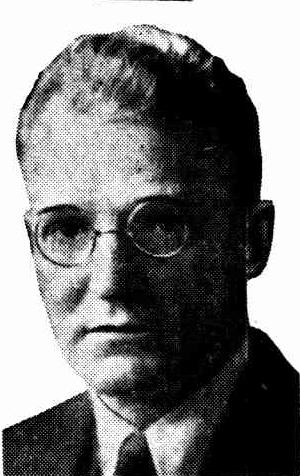 MEDICAL CHIEF TO EXECUTIVE HEAD
MEDICAL CHIEF TO EXECUTIVE HEADDR. HERBERT SCHLINK, former medical superintendent of the Royal Prince Alfred Hospital, has been appointed chairman of the board of directors of that institution, in succession to Sir Samuel Hordern. MEDICAL CHIEF TO EXECUTIVE HEAD (
1934, November 14).
Northern Star (Lismore, NSW : 1876 - 1954), , p. 9. Retrieved from
http://nla.gov.au/nla.news-article94494066
MATERNITY BLOCK WILL BE BUILT
PRESENT BUILDINGS OBSOLETE, SAYS SCHLINK
"We will build a new maternity block alongside the Royal Prince Alfred Hospital, if it takes us twenty years," declared Dr. Herbert Schlink, chairman of the Hospital Board, yesterday.
Dr. Sclilink and the Federal Minister for Health (Mr. Hughes) have been the strongest supporters of the scheme to build a model maternity hospital and ante-natal clinic close to the University. The Professor of Obstetrics at Sydney University (Dr. J. C. Win-dcyer) and some other medical men have objected that such a hospital is unnecessary, and the Jubilee Fund money might be spent to better advantage on research.
"Arguments about the expenditure of the Jubilee Fund for maternal and infant welfare have clouded the main issue," said Dr. Schlink, who added that the board had intended to build a maternity hospital whether the fund was raised or not. "The public subscription received for the fund, only £7500, is a mere drop ill the bucket. "It would scarcely pay for the foundations of a new hospital. If It is to be employed in another direction we can do quite well without it.
Will Cost £100,000
"There will be a tremendous saving by building the block next to the Royal Prince Alfred." he claimed. Plans included an underground corridor to connect the buildings, to enable the Royal Prince Alfred plant to be used. "The hospital we intend to build will meet Sydney's requirements for the next 100 years, he added.
According to Dr. Schlink, the building will cost about £100,000. and annual maintenance costs will be approximately £15,000. Dr. Schlink strongly criticised the existing maternity hospitals in Sydney.
"All obstetric hospitals in Australia are out of date in structure alone," he stated.
Modem equipment was also urgently needed. A new standard in obstetrical work should be given, and the tone of accommodation, research and treatment should be raised.
Contrary View
"There was small necessity at present to build a maternity block at the University, and the money could be better spent on research," said Dr. E. Ludovicl, who is attached to the Crown-street Hospital for Women.
"The Royal Prince Alfred Hospital and the University have well-equipped laboratories where attention could be devoted to solving grave problems affecting women," Dr. Ludovici said. "It is to the advantage of the Federal authorities to assist investigations which will alleviate women's disabilities. "Money could be better devoted to developing research departments in the two large and admirably conducted obstetric hospitals now in existence."
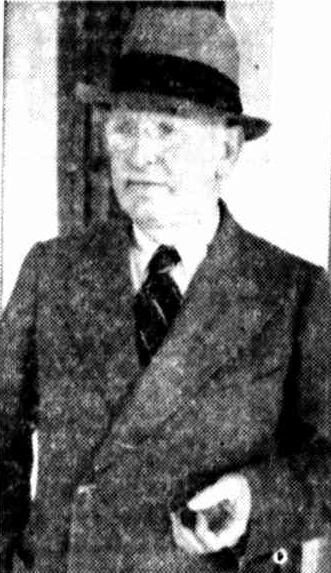 Dr. J, C. Windeyer, professor of Obstetrics at Sydney University, also claimed that the proposed block for midwifery was unnecessary. The Jubilee fund should be devoted to post-graduate training and research work. There were already sufficient beds for teaching students at the Crown-street Hospital and the Royal Hospital for Women. Dr. Constance E. D'Arcy reaffirmed the view, expressed in her Anne MacKenzie oration, that a large modern maternity hospital should be built near the University. Sydney's midwifery hospitals and the University were too far apart. Mrs. Jessie M. Street (president of the United Associations) : "A large part of the Jubilee fund should be spent upon creating new health centres throughout the State. Sydney urgently requires another 20 of them. We think that essential social services should be considered before money is spent upon a new hospital." MATERNITY BLOCK WILL BE BUILT (1935, November 3). The Sun (Sydney, NSW : 1910 - 1954), , p. 7. Retrieved fromhttp://nla.gov.au/nla.news-article230180691
Dr. J, C. Windeyer, professor of Obstetrics at Sydney University, also claimed that the proposed block for midwifery was unnecessary. The Jubilee fund should be devoted to post-graduate training and research work. There were already sufficient beds for teaching students at the Crown-street Hospital and the Royal Hospital for Women. Dr. Constance E. D'Arcy reaffirmed the view, expressed in her Anne MacKenzie oration, that a large modern maternity hospital should be built near the University. Sydney's midwifery hospitals and the University were too far apart. Mrs. Jessie M. Street (president of the United Associations) : "A large part of the Jubilee fund should be spent upon creating new health centres throughout the State. Sydney urgently requires another 20 of them. We think that essential social services should be considered before money is spent upon a new hospital." MATERNITY BLOCK WILL BE BUILT (1935, November 3). The Sun (Sydney, NSW : 1910 - 1954), , p. 7. Retrieved fromhttp://nla.gov.au/nla.news-article230180691
Back Home Again.
After an extensive tour abroad, and visiting hospitals in Great Britain and the Continent, Dr. Herbert H. Schlinck returned to Sydney on Thursday, 7th inst., by the Oronsay. Social News and Gossip (
1937, October 14).
The Catholic Press (Sydney, NSW : 1895 - 1942), , p. 8. Retrieved from
http://nla.gov.au/nla.news-article106338659
Dr. Herbert H. Schlink, chairman of the Royal Prince Alfred Hospital, after a study of hospitals in Great Britain and the Continent, arrived in Sydney by the Oronsay. DR. SCHLINK (
1937, October 14).
Goulburn Evening Penny Post (NSW : 1881 - 1940), p. 5 (DAILY). Retrieved from
http://nla.gov.au/nla.news-article99534643
Filled with ideas on what worked overseas, Dr. Schlink returned with plans for a Women's Hospital that would also be a teaching hospital for obstetrics and gynaecology. This was one of many projects for which the architect was A. G. Stephenson:
The board of the Royal Prince Alfred Hospital has approved plans for the King George V. Memorial Hospital for Women in Missenden Road, Camperdown.
The estimated cost is £318,000 and the architects are Stephenson and Turner. Opportunities for Business (
1938, November 9).
Construction(Sydney, NSW : 1938 - 1954), , p. 19. Retrieved from
http://nla.gov.au/nla.news-article222853403
Dr. Schlink with one of those statues:
FOR WOMEN
UNVEILING OF STATUE: LEAVING FOR AMERICA AFTER CHRISTENING.
DR. HERBERT SCHLINK, chairman of the hospital board, and LADY WAKEHURST beside the statue of Imhotep, ancient Egyptian god of medicine, after Lady Wakehurst had unveiled it at the Royal Prince Alfred Hospital yesterday afternoon. FOR WOMEN UNVEILING OF STATUE: LEAVING FOR AMERICA: AFTER CHRISTENING. (
1938, November 11).
The Sydney Morning Herald (NSW : 1842 - 1954), , p. 4. Retrieved from
http://nla.gov.au/nla.news-article17536541
'CHAMPAGNE AND BEER' DR. SCHLINK'S COMPARISONS NATIONALISATION OPPOSED
Nationalisation of hospitals by the State Government was strongly opposed by Dr. Herbert H. Schlink, chairman of the Royal Prince Alfred Hospital (Sydney) in evidence before the Joint Parliamentary Committee on Hospitals. He submitted proposals for Improving hospital finances. 'Any direct Government or municipal tax as a means of financing hospitals would be a mistake,' Dr. Schlink said. 'Where such taxes have been introduced the hospitals nave nearly always succumbed to the dead hand of departmentalism, and the general public sheds its responsibility and loses interest.' Dr. Schlink said that the crux of the present hospital problem was the need for financial stability. The hospitals were trying to live a champagne life on a beer Income. More money would have to be made available to the hospitals if they were to carry on, and he suggested increased grants from State revenue. 'It is easy to understand why the hospitals are in such a parlous financial condition,' he said. 'Since the State lottery has been Introduced the total number of hospital beds in New South Wales has almost doubled, yet the annual revenue obtained by the hospitals from consolidated revenue has dropped from an average of £615,036 to £168,133. In fact, in one year, 1932, £176,215 of the lottery money was retained by consolidated revenue.
EFFECT OF LOTTERY
'Had the State maintained the allotment of money from the consolidated revenue as up to the year 1931, and allowed the lottery money to be an additional subsidy, the hospitals would have been well provided for. Unfortunately, the State merely relieved itself of its old hospital responsibility by substituting the money from the lottery.' If it was the considered policy of the Government to retain the lottery, he said, it should be enlarged so that It would return more money. Totalisator and all amusement taxes, and some portion, if not all, of the tax derived from the sale and manufacture of alcohol, should be reserved for the alleviation of human suffering. If sufficient funds were not obtained from those sources, there should be a stamp tax on matches and tobacco, such as existed in Italy. Voluntary social Insurance schemes, such as the Metropolitan Hospitals' Contribution Fund, should be made compulsory , he said, and all hospitals should be encouraged to become community hospitals by the erection of paying or part-paying pavilions. The profits from such activities would be an off -set against their Indigent beds, which were a total financial loss to the hospital. VOLUNTARY MEDICAL SERVICE
He advocated the retention of the present voluntary medical service to the indigent, saying that it provided a better service to the public than would be obtained by any paid service. Maintenance costs could be lowered by the establishment of sub-acute and chronic hospitals. Because most of the large metropolitan hospitals had nowhere to send their long-term cases, many patients were in beds which cost £4 a week to maintain, who could be adequately treated in £2 beds. The Australian public, especially the poorer section, had better hospital facilities, at a far cheaper cost, than world average. The financial burden on the purse of the community was not heavy when compared with other burdens. Public hospitals cost the community about 13/6 a head, compared with £5/18/6 a head for public houses, and £2/9/ a head for public schools. The Hospitals (
1939, October 9).
Daily Advertiser (Wagga Wagga, NSW : 1911 - 1954), p. 5. Retrieved from
http://nla.gov.au/nla.news-article144250553
MODEL HOSPITAL FOR N.S.W. MOTHERS
There has been some controversy of late, on the subject of hospital units, especially with regard to the isolation of the maternity units from the medical.
The following article by Dr. Herbert H. Schlink, M.B., Ch. M., F.R.A.C.S., Chairman of the Royal Prince Alfred Hospital, is a striking exposition of the theory that medical and maternity hospital units should not be isolated one from the other. Hence the decision to erect, as a unit of the R.P.A.H., the King George V. Memorial Hospital for Women (see illustration on Page 5). Dr. Schlink points out that confinement is not a disease, but the reason why so many are forced into hospital is not hard to find.
"The modern woman," he said, "has taken to cocktails and cigarettes, indulges freely in dietetic indiscretions, lives under the stress and strain of financial and social worries, feeds her mind on doubtful and exciting literature, is harried by telephone and wireless, and rushed about by motor cars and flying machines so that she comes to the couch of travail unfit and tired, notwithstanding the new liberty in outdoor sport and musically-conducted exercises."
As chairman of the Royal Prince Alfred Hospital, I am in the happy position to tell the public that the board, with the help of the Premier and the Minister for Health, and the moral support of the present and late Federal Ministers for Health' has made financial arrangements to proceed with the erection of a modern, model hospital for women that will be second to .none in the world. It is proposed to call it the "King George V. Memorial Hospital for Women." When completed it will contain 200 beds. Preliminary sketch plans and estimates have already been placed before the board of directors. Of late, there has been much discussion in the Press as to where such units as we propose to build should be situated. After a recent world-wide inspection of women's hospitals and "Frauen Kliniks" in Britain, Germany, Denmark, Sweden, Poland, Czechoslovakia, Austria, Hungary, Italy, France, Holland, Belgium, Greece, Turkey, and other Balkan Stales, as well as Egypt, America and Canada, I am thoroughly convinced that the day of the specialised hospital, built apart from general hospital centres, is finished. The modern trend is to plan and construct hospital villages, or cities, with separate _ and .distinct pavilions for each speciality in close geographical relation to each other.
THE day of the American skyscraper hospital also is doomed. At least, the idea is doomed in Europe, where all authorities are satisfied that nothing higher than six to eight stories should be erected. Charts and graphs, showing conclusively the economic reasons for such limitation, can be inspected at nearly every modern centre in Europe. Practical proof of this is seen throughout the world to-day. The best examples arc the new Birmingham Centre and the new Heidelberg University Village. Those cities which have built isolated "specialised" hospitals in the past are, as fast as finances will permit, shifting them near their main hospital centres, e.g., Edinburgh, Manchester, Stockholm, &c, But probably the best example of the fallacy of building specialised hospitals long distances from general hospital activities is the Chicago Lying-in Hospital. This is one of the most famous and best-conducted obstetric hospitals in America. After occupying two sites away from general hospital areas, because its founder, Dr. De Lee, originally believed in obstetric isolation, it was discovered to be too far away from the University laboratories and the medical school. A new hospital was built within two miles of the University Centre, but; when occupied, it also was found to be too far distant. The directors had the courage to cut their losses; they scrapped their second new home and, with the help of the University built an entirely new hospital of 180 beds for maternity and gynaecology within the University grounds at an expense of £500,000 — nearly £3000 per bed in Australian currency.
WERE is what the founders, J. B. de Lee, M.D., and F. L. Adair, M.D., have to say about the hospital which occupied four different sites before a correct solution of this obstetrical problem of Chicago was solved: — "The affiliation of the Chicago Lying-in Hospital with the University of Chicago brought advantages to both institutions. The hospital needed the University to provide the laboratories and the men for research; to establish a gynaecologic service to co-operate with the maternity, thus making a real 'Frauenklinik' on the German plan, and to continue and develop in the antenatal clinics the study of the borderlands of obstetrics with pediatrics,, surgery, syphilology and other specialities. "The University was able to establish a complete department of obstetrics and gynaecology, medical students having access to the wards and delivery rooms. Advance in general medical knowledge will be hastened by co-operation with the obstetrician and gynaecologist and the specialists of the other clinical departments of the University have here unlimited opportunities to broaden their vision and their usefulness. One' of the most valuable advantages will be the application of the sciences ancillary to medicine to the study of general diseases in pregnant women."
MOST European cities have never made the basic mistake of isolating their medical units. Berlin, Munich, Leipzig, Vienna, Copenhagen, and London, where the financial aspect prevents such medical and sudden change of plans instanced above, have got over the problem by adding obstetric wards with horizontal isolation, or erecting new pavilions, e.g., St. Bartholomew's, Guy's, The London, St. Thomas'. Westminster, University College, King's College, St. Mary's, Middlesex, The Royal Free Hospital for Women, &c. There is no doubt whatever that the N.S.W. Government's policy of adding separate and isolated wards, or new additions to the existing country hospitals, and building separate pavilions for the chief metropolitan hospitals is 100 per cent, correct, and in conformity With hospital practice throughout the entire world. Some people believe that, Australia, being a new and young country, can afford to strike a revolutionary line of development in obstetric construction; but I hope the vast sums of money that will be needed to bring up to date our obstetric facilities will not be unwisely spent on the advice of well-meaning idealists who dare to teach their grandfathers of the Old World.
THE public should realise that the present State Government is straining every nerve to rectify the mistakes and overtake the deficiencies in health matters which were bequeathed to them by the predecessors of the last 37 years. As chairman of our oldest teaching hospital, I am astounded that they have been able to accomplish so much in so short a time, realising, as I do, the amount of thought and money that efficient modern hospital construction entails. Advocates of the lonely, specialised obstetric hospital forget that pregnant women are just as liable as their nonpregnant sisters to suffer from all the ills the human body is heir to, from carious teeth to cancers, skin diseases, and a variety of toxnemins. The unit our directors envisage will admit such complicated cases and deal 'with them thoroughly, as we have 137 honorary specialists attached to the staff of our hospital centre, as well as having the whole of the University laboratory facilities to assist in the elucidation of medical problems.
I AGREE with those who urge that the accommodation for uncomplicated cases, homes for expectant mothers, ante-natal clinics and convalescent homes, should be conducted with as little hospital atmosphere as possible. More of these cases should be dealt with in their own homes by a well-organised and well-trained professional team— doctor, nurse and student— provided, of course, that only normal multoparous patients are handled, and provision is made for proper hospital care and transportation if emergencies should arise. The fact that for the year ending June 30, 1937, 6000 others successfully delivered themselves at home, without the aid of a doctor, shows the possibilities for the development of such a service. Our mothers of 50 years ago lived a much more placid, expectant life, and so had fewer difficulties' and complications during childbirth than their present-day sisters. This is a factor that the scaremongers on mortality forget, and accounts for the better results obtained in the different districts and countries. Women brought up in the country, and domesticated women who grew up under simple and frugal parental direction, stand a much better chance of an uncomplicated labor than women addicted to social gaiety and late hours, or those who live, during their carrying period, in picture shows and restaurants. All the progress that modern medicine has made in preventing and curing intercurrent diseases has been more than offset by the change in the social habits of our women, and this factor must always be given due weight' when considering mortality rates for different races and different occupations.
AGAIN, all the talk about the "dirty nurse" and the "dirty doctor" is so much nonsense and all informed persons know that a large percentage of women go to their bed of labor with internal disease which has often existed before they first became pregnant. It should be known that the patient, more often than not, contains the germs of septicaemia within herself and that the attending doctor or nurse is powerless to prevent their invading the blood stream. If well-intentioned people who are constantly attacking the profession and public authorities about mortality will remember these two factors when considering the rate, we will be nearer the solution of the obstetric problem that confronts this Stale. The small unit which the Royal Prince Alfred Board is about to erect and conduct will have far-reaching results in the study of disease in the pregnant woman, and, without interfering with the excellent facilities which the Professor of Obstetrics has established for students in the existing well-conducted obstetric hospitals, will provide a home for post-graduate study for 50 doctors and many nurses annually. Nobody will deny that the better qualified the doctor and the nurse the better will be the obstetrics throughout the State. Moreover, the present undertaking will give the Government a guide to a model construction for any future hospitals which finances permit them to erect in the various suburbs and large towns of the State.
MODEL HOSPITAL
King George V. Memorial Hospital for Women, as it will appear on completion. (See article on Page 4.)
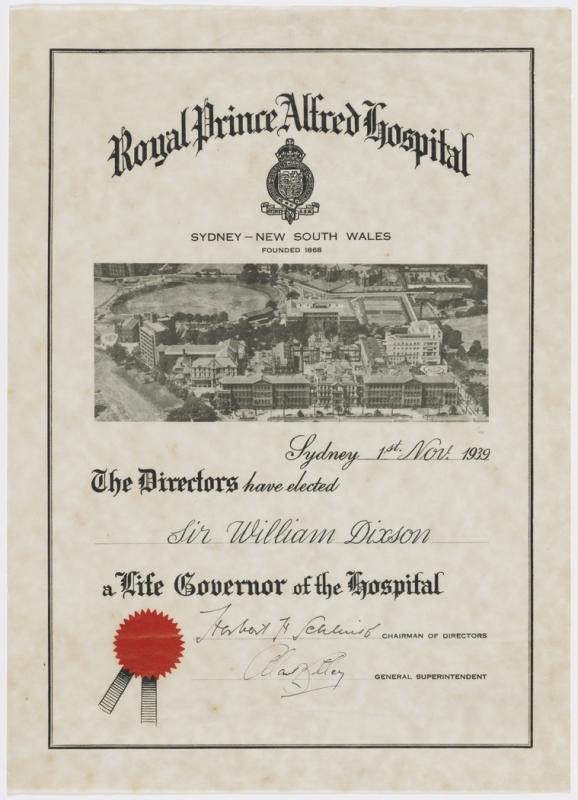
Royal Prince Alfred Hospital life governor's certificate electing Sir William Dixson, 1 November 1939. Image No.: a7182001, courtesy The Dixson Library, State Library of NSW. Signed by RPAH Chairman of Directors H H Schlink.
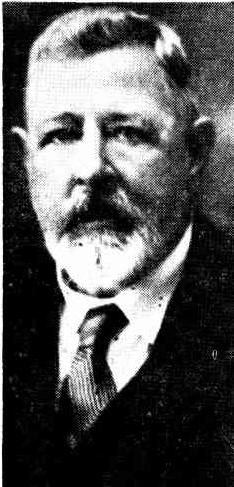
Sir William Dixson (18 April 1870 – 17 August 1952) was an Australian businessman, collector and benefactor who bequeathed his collection of over 20,000 items of Australiana to the State Library of New South Wales, forming the Dixson Library.
In recognition of his public benefactions, in 1937-39 William Dixson gave a total of £5000 to assist in establishing a library at the New England University College, Armidale, which is named in his honour; he also presented some 1500 anthropological specimens from Australasia, New Guinea and the Bismarck Archipelago to the Australian Museum, he was knighted in the New Year Honours of 1939.
Just as his parents had done prior to him,
Sir Hugh Dixson (1841-1926), he donated generously to hospitals, the RPAH among them. His mother had been made a Life Governor of RPAH as well.
New Sydney Hospital Offered To Military Authorities
SYDNEY, Friday.— The Defence Department has been offered the use of the almost-completed King George V Memorial Hospital for Women at Camperdown. The hospital, which will have 263 beds, is controlled by Royal Prince Alfred Hospital. It was intended to be a maternity hospital. . An appeal will be launched In August for £25,000 to equip the hospital. The general superintendent of Royal Prince Alfred Hospital (Dr. A. B. Lilley) said that most of the obstetric equipment could be used for general work. A number of beds in the general hospital will also be made available to the military authorities,' he added. Other metropolitan hospitals have also offered fully-equipped beds for military purposes. At. Prince Henry Hospital a new infectious diseases block will probably be built, to make 240 beds In the general hospital available for military use. New Sydney Hospital Offered To Military Authorities (1940, June 29). The Courier-Mail (Brisbane, Qld. : 1933 - 1954), , p. 2. Retrieved from http://nla.gov.au/nla.news-article40948255
The appeal finally raised was £45,000 - all raised by the Ladies Auxiliary.
For Women -RECEPTION AT HOSPITAL
MATRON H. B. HETHERINGTON, matron of the new hospital, and Dr. H. H. SCHLINK, Chairman of the board of directors of the Royal Prince Alfred Hospital receiving DR. HELEN MACDONALD at the opening of the King George V Memorial Hospital for Mothers and Babies at Camperdown last night Dr. MacDonatd will begin her duties as an assistant anaesthetist at the hospital this morning Also in the picture are DR. A. J. COLLINS, a member of the Board of Directors, and MRS. COLLINS. For Women.—RECEPTION AT HOSPITAL (
1941, May 9).
The Sydney Morning Herald (NSW : 1842 - 1954), , p. 4. Retrieved from
http://nla.gov.au/nla.news-article17748846
The Matron pictured here is the very good friend of
Muriel Knox Doherty, overseeing her acquiring of a home at Avalon Beach. Muriel was also supported in her endeavours by Dr. Schlink.
The trip to America, and subsequent trips abroad seeing medical institutions working on a grand scale with aligned disciplines working together within one campus inspired Dr. Schlink to attempt the same thing for Australia and his beloved RPA and in seeing a shortfall that would follow WWII - this plan, fortunately
, did not materialise on the scale Dr. Schlink envisioned in his ever expanding roles for the RPA and the structures required for these - the
RPA of today though is a very close version of this - health, research, teaching, a long list of first in the Australia developments in medicine and operations remain part of the RPA vision
:
A National Medical Centre In Sydney to Cost £3,000,000
By Dr. H. H. SCHLINK, Chairman of Directors of the Royal Prince Alfred Hospital
Governments everywhere are planning to make better medical services available to all in post war years. If Australia is not to lag behind it behoves all in this State who will be responsible for the education of the huge medical, nursing and technical personnel needed for this purpose to make early plans for the organisation of this teaching; other wise schemes, splendid on paper, will, fail through a lack of properly educated men and women to conduct them.
A pen and ink impression of a part of the proposed Medical Centre.
CONSCIOUS of oversea activities in the hospital world, and realising the need for better medical services, the directors of the Royal Prince Alfred Hospital have decided on the founding of a national medical centre round the only medical school In New South Wales at Sydney University.
The board Is convinced that proximity to the University and Its libraries, museums, and laboratories will necessarily determine for all that the site of the National Medical Centre, and has already purchased some of the necessary land. Its plan for this centre means the remodelling of a portion of Camperdown near the Royal Prince Alfred Hospital, the erection of modern buildings for preventive medicine, curative treatment, clinical teaching, and medical research, and the provision of an additional 2000 beds. The cost of the centre is estimated at £3 millions.
With Government aid the hospital wishes to resume the whole of the area on the western side of Missenden Road as far as Australia Street, and re-plan the area with streets lined by modern medical buildings erected to cope with the rapid expansion of medicine.
No other city in the world has such an ideal area for the purpose proposed. It is an area which will make future, hospital and education progress economically sound.
Ten Years to Complete
The buildings planned by the directors are estimated to take under 10 years to complete, but with the help of the Government and the community, the whole could be in occupation within five years. A start has already been made by the erection of the King George V Memorial hospital for Mothers and Babies, the steam service building:, the workshops, and the laundry, all of which occupy their permanent sites in the general plan.
The outpatient and casualty polyellnic is the gate or doorway to the whole village of teaching hospitals. It is to this that patients will come from city and suburbs to be treated for minor illness or accidents, for purposes of diagnosis, and for the treatment of chronic Illness.
Paticnts will be admitted to the various hospitals through It, and those discharged Will attend it for their follow-up. Small wards and an operating theatre will be attached to the casualty-room. In the wards cases will be kept no longer than 24 hours; after that time the patient, if not well enough to be sent home, will be sent to one of the constituent hospitals. The main dispensary, dental clinic, and ambulance station will also be in this block.
The diagnostic therapeutic unit will be located in a central building to serve both outpatients and bed patients. The X-ray plant, the blood bank, the haematology department, biochemistry department, physiotherapy and other highly specialised departments and laboratories are also situated here.
It is proposed to construct new pavilions for general medicine and general surgery, and new hospitals specially adapted and equipped to suit each specialty will be built. Sites have been allotted for a cancer institute, a post-graduate hospital, pavilions for sub-acute and chronic diseases, and a hostel for the dying.
The construction of a nurses' home with about 2,000 bedrooms is considered vital, and the present home will be converted into residential quarters for medical officers, post-graduate students, and medical students in residence during their fifth and sixth years.
A College of Nursing Is planned to embrace the whole range of nursing Instruction.
Other schools will be provided for the allied callings necessary to give a complete health service to the community; dietitians, physiotherapists, almoners, instrument assistants, and provision for apprenticeship in all callings relative to hospital service.
A residential hostel for Hospital Workers as well as one for country students is also contemplated. With such a community living within the centre, a. community auditorium for meetings shows and conferences would be required. and a site has been reserved for this purpose. With resident workers, married workers and their families, ambulatory patients and visitors, the daily community of the centre would probably number 20,000.
Provisions within the plan for the centre Include the use of one of the nearby parks for an airfield for any patients who in the future are transported by air.
The hospital survey made by the Parliamentary Joint Committee on Social Security revealed inadequate hospital facilities throughout Australia, and that tile City of Sydney in particular was short of world standard requirements
The Sydney Faculty of Medicine is already facing a serious situation in practical hospital instruction for its ever-increasing number of medical students. Last year, for the 164 students in the three teaching hospitals, there was only one bed to every four students instead of the standard laid down by the latest British authority of one student to 10 beds. An adequate community medical service cannot be obtained if future doctors are not provided with necessary practical experience.
Various organisations, institutions, and individuals who co-operate with the national medical centre will not lose their identity. The Royal Alexandria Hospital, for example, would be managed by its independent board, and would only participate In certain common services to reduce costs and co-ordinate its student time-table With that of the centre. A National Medical Centre In Sydney to Cost £3,000,000 (1945, July 11). The Sydney Morning Herald (NSW : 1842 - 1954), , p. 2. Retrieved from http://nla.gov.au/nla.news-article17946585
The original hospital, a three-storey square building with basement, was based on the design for St Thomas's Hospital in London and classified by the National Trust. The facades of the Queen Victoria and Prince Albert blocks, added on either side in 1901, are also classified, as are the original nurses' home, Gloucester House and the King George V Hospital.
Another statue!:
The Duke Approves Statue
The much-discussed statue of King George V at the King George V. Memorial Hospital, Camperdown, was unveiled by the Duke of Gloucester. The Duke said he thought the statue was "very good."
"I am very pleased to extend my family's connection with this hospital by unveiling this statue” said the Duke, pulling the cord. The Duchess of Gloucester, who screwed up her eyes as she inspected the statue, said; "I am intrigued by it."
Doctors from the King George V. Memorial Hospital, in front of which the statue has been placed, said it was dreadful. Audrey Laws (14), of Camperdown, who came to the unveiling ceremony carrying her baby sister, said it was lovely. "Is It a Shroud?" -
Andor Meszaros designed and carved the unusual and radically different conception of the late King, standing with bowed head and carrying a sceptre. The coronation robe' is bare of ornament, and spectators in the crowd asked: "Is it a shroud?"
Meszaros used an 8 ½ ton block of Australian marble to carve the 2 ½ ton figure. Chairman of the hospital (Dr. Schlink), welcoming the Duke and Duchess said the statue was Inspired by the artist's desire to represent the late King, not as a soldier, warrior, diplomat, ruler or supreme commander, but as the spiritual head of the charitable activities throughout the Empire.
Afterwards. Dr. Schlink said that the simple dress of the statue was designed to prevent it from becoming dated. The features were exaggerated because the statue had to stand in the weather, and a thin nose and ears would he likely to drop off after time. Hundreds watched the unveiling.
STATUE of King George V., which was unveiled today by the Duke of Gloucester at the King George V. Memorial Hospital. It is the work of Andor Meszaros. The Duke Approves Statue (1947, January 10). The Sun (Sydney, NSW : 1910 - 1954), , p. 2 (LATE FINAL EXTRA). Retrieved fromhttp://nla.gov.au/nla.news-article229994286
Meszaros was a Hungarian sculptor who settled in Melbourne in 1939. He was introduced to Herbert Schlink by Architect A. G. Stephenson, who designed the Chapel among other structures already listed above. Meszaros’s most prominent commission was perhaps the medals of the
1956 Olympic Games. Two other statues of his “Maternity” and "The Surgeon" were also installed in the Royal Prince Alfred Hospita grounds - these were made of Hawkesbury sandstone while the statute of KIng George V was sculpted from Queensland white marble for which the sculptor needed special tungsten chisels
Dr. Schlink's Address
The best hospital systems of the modern world had grown through the co-operation of voluntary and Government enterprise, the president of the newly formed Australian Hospital Association, Dr. H. H. Schlink, said at the first general meeting of the association yester-day.
"Some persons believe that the voluntary system to-day cannot do the whole job," he said . "Others feel that complete Government control cannot do it. The obvious solution is for the two systems to work together in collaboration, consultation, and harmony.
The two essentials necessary for success are money and knowledge. Governments have the financial strength no longer within the reach of voluntary effort, but the right use of that strength to the ultimate good of the community depends on the co-operation of the medical profession, the administrative agencies of hospitals, and the consumers of hospital services." CO-OPERATION IN HOSPITALS (
1947, February 18). The Sydney Morning Herald (NSW : 1842 - 1954), , p. 3. Retrieved from
http://nla.gov.au/nla.news-article18015498
Your Illnesses Get More Costly
Hospital Expenses Are Still Soaring, But You Get Fewer Comforts
By. A STAFF CORRESPONDENT ,
SOARING costs are forcing a crisis in the affairs of our hospitals. Since 1940 costs of hospital treatment have increased 150 per cent., and they are still rising. In one big Sydney hospital it costs £675 a year to maintain a bed, compared with only £268 in 1940. Factors that account for this are wage increases for nurses and domestic staff, the 4,0hour week, and higher prices for food, drugs, and surgical equipment.
MORE than a score of private hospitals in Sydney have been forced to close in the last two years. Even the big hospitals are so costly to run that their administrative staffs are battling to make ends meet.
Last year most hospitals were compelled to increase charges for accommodation in private wards very steeply. This has forced many patients, unable to pay the cost of a bed in a private ward, to press for free- treatment in the overcrowded public wards.
But the more immediate effect of the cost rise is to force even our best hospitals to economise-not in essential services, but in many ways which must in the long run seriously reduce standards of comfort.
Our hospitals will resist to the limit any temptation to cut down on things which could reduce the efficiency of the service they perform for the sick and injured. But in a desperate attempt to make ends meet and live within their fixed incomes, they now find themselves obliged to economise on such things as equipment for the wards, apparatus for . their technical workers, and general hospital improvements.
Patients will get the same medical care but they will not get the same comforts and luxuries.
WHEN the war ended in 1945 the taxpayers of New South Wales were paying £1,700,000 a year to-ward the upkeep of our public hospitals.
That was the total subsidy paid by the State Government to the Hospitals Commission for distribution to more than 200 public hospitals in this Slate.
Today the taxpayers are paying £6 million towards the upkeep of these hospitals. That includes £4 million paid by the State Government and about £H million paid by the Commonwealth Government out of the social service contribution which the people pay with their income tax.
That jump, from £1,700,000 to £6 million in four years, shows how our hospitals have had to call upon Governments for bigger and bigger handouts to bridge the widening gulf between expenditure and revenue.
Take the case of Australia's biggest hospital, the Royal Prince Alfred, in Sydney. This is what it has cost to maintain a bed in this hospital each year since 1935:
Average cost per bed. £
1935 . 194
1940 . 268
1945. 356
1946 . 386
1947 . 481
1948 . 573
1949 . 675
Dr. Herbert H. Schlink, chairman of this great hospital, and probably the leading authority on hospital administration in Australia, says:
"If we knew the cost-price spiral had been checked we might know where we stand. But the end is not in sight. Costs arc still rising in every department. At this rate it is appalling to think what we may be faced with before the year is out."
The matron of a private hospital says:
"The way costs keep on mounting up just makes me gasp. If something isn't done to check it the private hospitals will soon be-empty because we shall be forced to charge prices beyond our patients' means."
ALL hospitals have increased their charges to patients in the last few years, some by 50 per cent., some by 100 per cent., a few by 150 per cent. Even then they bear little relation to actual costs.
"If we put up our charges in proportion to our costs we wouldn't have a patient in the place," says the chairman of a private hospital.
Under the Hospital Benefits Act, patients in public wards are now treated free, the Commonwealth Government compensating the hospitals by paying 8/ for each patient a day (£2/16/ a week).
Under the same scheme the patient in a private ward gets a rebate of a similar amount (£2/16/ a week) off his bill. This, in effect, substantially reduces the cost of his illness, though the relief he gets from the rebate is counter-balanced, of course, by the, amount of the social benefits contribution he makes to the Common-wealth Government when he pays his taxes...
CHARGES such as these naturally vary greatly according to how heavily a hospital is endowed and the extent to which it is subsidised.
Private hospitals, for instance, are not subsidised at all; they receive the social benefits contribution of 8/ a day for each patient, but that is all.
Of course, a patient in a private hospital has to pay more than the charge for his bed. He will find, for example, that the charge for the use of the operating theatre has gone up from £2/2/ in 1936 to £3/3/ or £3/10/ to-day (if he is undergoing a major
Here are some Royal Prince Alfred Hospital figures (remembering that the hospital had 736 occupied beds in 1940 and 1,172 to-day):
1940 1948 £ £
Wages . 118,000 458,000
Food . 38,000 114,000
Drugs . 16,000 61,000
Fuel, power . 9,000 25,000
Bedding, laundry, etc .. 9,000 28,000
General-expenses . 9,000 27,000
X-ray, pathological, etc . 9,000 17,000
Repairs . 8,000 20,000 operation) and from £1/1/ to £1/15/ (for a minor operation).
Drugs (for which the private ward patient also pays) are very expensive, and are used much more generously than they were a few years ago. A doctor relates how a patient who recently paid 25 guineas in doctors' fees had to pay £89 in addition for drugs before she was cured.
BIGGEST. factors in present-day hospital maintenance costs are wages and the effect of the 40-hour week. In 1937 a first-year nurse was paid £1/13/6 a week. Under the Kinsella award of 1947 she is paid £3/12/. A senior sister who got £4/6/ in 1937 gets £7/16/ to-day, with an additional 5/ if she is employed on an obstetrical case.
These increases lifted the wages bill at Royal Prince Alfred Hospital by about £50,000 last year. But the wages of all other hospital employees have gone up, too, as a result of basic wage rises and higher penalty rates. In addition, it is estimated that the 40-hour week, which now applies to all hospital employees, has raised bed costs by 10 per cent.
Three or four years ago coal could be bought for 34/44 a ton; now it is 60/3. Milk has gone up from 1/4 to 2/54 a gallon; crepe bandages from 1/44- to 2/0 each. Since 1941 the meat bill at one hospital has gone up from £700 to £2,200 a month. The story is the same in every other department of our hospitals. Your Illnesses Get More Costly (1949, February 27). The Sunday Herald (Sydney, NSW : 1949 - 1953), , p. 2. Retrieved fromhttp://nla.gov.au/nla.news-article18464827
10,000 On Hospital Waiting List MANY WHO NEED TREATMENT ARE TURNED AWAY
By Our Special Reporter
Sydney is so short of hospital beds that 10,000 people needing: medical or surgical attention are on hospital waiting lists. Doctors say that the condition of many of these people is becoming progressively worse and their chances of recovery lessens by the delay in treatment.
Some hospitals have waiting lists of 2,000 names. One, Royal Prince Alfred, has 4,800 names. It will take from three weeks to nine months to find beds for all these people.
While they are waiting, they will be denied the surgical opera-tions or hospital treatment which their doctors have advised. There are 22,200 hospital beds in the'State; another 2,000 to 3,000 are needed in Sydney alone.
Three Months' Wait For Operation
To blame for this situation
are:
- The war.
- Failure of successive State Governments to appreciate the health needs of the growing population.
- The disinclination of the present State Government to give new hospitals top building priority.
- Abolition by the Federal Government of the patients' means test. This has precipitated a rush for free medical treatment for which our existing hospitals were totally unprepared.
Only if you are dying, or very very ill, can you hope to get a bed- promptly in any of our big hospitals. If you try to get into the Royal North Shore Hospital, for example, you will be told that you must wait three weeks to get a bed for medical treatment, any-thing up to three months if you need a surgical operation, up to nine months for orthopaedic treatment, and from six to nine months for treatment of chest diseases.
Consequences Can Be Alarming
Doctors who are trying every day to get their patients into hospital will tell you that that is typical of nearly all Sydney's big hospitals. The consequences can be alarming. Here arc some of the things that happen:
People suffering from haemorrhoids, gall bladders, and other painful growths have a low priority in their claims upon hospital accommodation and must suffer agony for as long as six months before a hospital will admit them.
People suffering from allergic complaints, like asthma and eczema, have to wait up to three weeks for a hospital bed, suffering acute depression and irritation.
Women have to book beds in maternity hospitals eight months ahead for their confinement.
Accident Victims Cannot Stay
If they suffer complications after childbirth they have little chance of getting into hospital, 'where 15 days' treatment would set them right. Instead, they have to suffer at home, where domestic duties deprive them of the rest they need.
Victims of road accidents who are suspected of having suffered brain injury are not permitted to occupy hospital beds for more than a few hours. Surgeons claim that a stay in bed for at least 24 hours for observation is essential.
Convalescence after illness or operation is reduced to dangerous limits. A relapse in the home, where proper observation and attention are lacking, sometimes has fatal results.
As for the elderly sick, the bed-ridden, the chronically ill, and the troublesome-they have hardly a chance in the world.
No matron would risk admitting a patient whom she might have on her hands for years, occupying a precious bed which could accommodate 15 or 20 urgent surgical cases every 12 months. And if her heart melted, and she took the patient in, as likely as not the entire staff would walk out.
Must Languish-and Die-At Home
If you are over 60 and bed-ridden you are not popular in hospital. You must languish at home -and probably die sooner than you. otherwise might
Here is what a leading Sydney allergist says of the hospital bed shortage:
"It takes from 10 days to three weeks to get a serious asthma or eczema patient into any hospital in Sydney. That is quite useless and most damaging to the patient. -
"The people I refer to suffer severe asthma continuously and require oxygen or adrenalin injections every two hours day and night. Their only hope of relief, in some cases their only hope of life, is to get into hospital quickly for constant treatment. But this is denied them. Because of the shortage of beds, which they are told are needed for more urgent cases, . they go home to suffer and, I regret to say, in some cases to die.
"Sydney could do with a hos-pital for asthma cases alone. It could be kept going every day and all the year with the most severe type, status asthmaticus, alone."
Makes Extra Work For The Staff
Besides piling up pain and misery for a lot of people, the hospital bed shortage makes extra work for nursing and medical staffs and contributes to the feeling of irritation and frustration you find in many hospitals.
Some doctors, more short tempered than others,, admit that after telephoning a dozen hospitals in vain for a bed they have in desperation called an ambulance, bundled the patient inside, and had him dumped on the near-est hospital doorstep.
If it is an urgent case, demanding immediate treatment, the patient gets a bed at once. But the doctor guilty of such summary and unorthodox action runs the risk of having his name jotted down in the matron's black book, and he may quite easily get a cool reception when next he speaks to her on the telephone.
Sydney doctors estimate that the city Is short of from 2,000 to 3,000 hospital beds. And they see no prospect of the shortage being ovçrcome for many years.
Top Priority To Home Building
When the war ended in 1945, all of Sydney's big hospitals had plans for increasing their accommodation. In the aggregate, those extensions would have cost £15,000, 000 and provided beds for neatly 100,000 more patients a year. *(
Two big hospitals alone, Royal Prince Alfred and Royal North Shore, each have building projects costing -£2 ½ million.
But the State Government refused permission to build. It allotted top priority in building materials only to houses, and allowed schools and hospitals to compete for second and third places.
Under this division of priorities, the needs of the sick and ailing came off Very badly. In the past year a limited amount of building has been ¡permitted outside Sydney, notably at Newcastle" and Wollongong, and in the outer environs of ¡Sydney a new hospital is going up at Bankstown, and tenders have ,been called for others at Hornsby and Sutherland, but except for additions at Crown Street and St. Margaret's Women's Hospitals, nothing has been done to tackle the problem where'it,is most urgent and the bed shortage presses hardest-in the city. ''
The three new hospitals at Bankstown, Hornsby, and Suther-land will provide another 660 beds. But that (is not enough. Commission Policy Is "Dangerous"
Sydney doctors say that the Hospital Commission's policy of shorter stay-ins for patients relieves the pressure on hospital space but brings many dangerous risks in its train and is in the interests neither of the patients nor the doctors.
Much harm can be done, they say, by forcing patients to vacate beds before their full course of treatment is completed.
The medical superintendent of one Sydney hospital put it this way:
"A great deal of clinical acumen is required to assess the risk of discharging a patient.
"A modern hospital, with its life-saving machinery, is well equipped to do this, but it does not follow that because a patient is discharged he is fitted to return to his home.
"The proper place for many of these patients is a convalescent or rest home and accommodation in those places is even harder to find than it is in a hospital.
"The fact is that because of the bed shortage a great many people who badly . need from one to two weeks' convalescence after operations or serious illness are not getting it."
Dr. H. H. Schlink, our leading authority on hospital administration, claims that the recent craze in America for reducing the patient's stay-in is over.
He says it has been found wanting in too many vital medical respects to have had anything more than a passing vogue. 10,000 On Hospital Waiting List (
1949, May 1).
The Sunday Herald (Sydney, NSW : 1949 - 1953), , p. 6. Retrieved
from http://nla.gov.au/nla.news-article18467232
Romance Takes Toll Of Graduate Nurses
SISTER ELAINE BARCHAM came from sick bay at Royal Prince Alfred Hospital yesterday to receive her nurse's diploma from the wife of the Prime Minister, Mrs. R. G. Menzies.
"I hope you don't marry too soon," the chairman of the Royal Prince Alfred Hospital Board, Dr. Herbert Schlinck, said in his address to 20 girls,three of whom are already engaged, when the wife of the Prime Minister, Mrs. R. G. I Menzies, presented them with their nurses' diplomas at the hospital yesterday.
"Looking around me, I feel that Dr. Schlinck's wish is I doomed to failure," Mrs. Menzies remarked.
Commenting on Dr. Schlinck's statement that expenses were rising so rapidly that a hospital bed, which once cost £72 a year to maintain, now costs £800, and may soon be £1,000, Mrs. Menzies said, "These figures frighten I me. They give the impression that at some stage we may not be able to afford hospitals, and I think that the position will indeed be bad when we cannot have large hospitals such as this i in which to train young doctors 1 and nurses to help others."
Except for Dr. H. Selle, Matron M. Looker, examiners, and sisters, most of the guests at the ceremony yesterday were country people who had come to see their daughters graduate.
Sister Margaret Hughes (Newcastle) and Sister Judith Thompson (Bathurst), who graduated yesterday, will leave for England in the Moreton Bay next January, with Miss Ann Macansh, to continue their studies abroad.
The nurses held a small party after their graduation yesterday, but as most of them were on night work they deferred their celebrations until the dance at the Pickwick Club being arranged by the fourth-year students for May 31.
Mrs. Menzies, who has been in Sydney since Friday, returned to 'Canberra by air last night. Romance Takes Toll Of Graduate Nurses (
1950, May 4).
The Sydney Morning Herald (NSW : 1842 - 1954), , p. 12. Retrieved from
http://nla.gov.au/nla.news-article18168747
U.S. Honour For Dr. H. H. Schlink
The chairman of the Royal Prince Alfred Hospital, Dt. H. H. Schlink will leave Australia today to attend the congress of the American HospitalsAssociation. Dr. Schlink is the first doc-tor from a non-American country to receive an invitation to the congress, which will be attended by 10,000 doctors from all over America, including Canada.
He will also receive honorary membership of the association, which is the highest honour that can be bestowed upon a doctor from a non-American country.
Dr. Schlink announced his departure for overseas at the opening of the new laundry block at the R.P.A. Hospital yesterday. He will also attend the International Gynaecological. Congress in Paris on June 23, and the International Hospitals Congress at Brussels on July 15.
At yesterday's ceremony, Mr. A. G. Stephenson, one of the architects who designed the new £130,000 laundry block, presented Dr. Schlink with a plaque from the standards committee of the American College of Surgeons. The plaque was in recognition of the outstanding work done by the R.P.A. The American College of Surgeons gave the plaque to Mr. Stephenson, during a recent visit to America, for presentation to Dr. Schlink. U.S. Honour For Dr. H. H. Schlink (1951, May 5). The Sydney Morning Herald (NSW : 1842 - 1954), , p. 4. Retrieved from http://nla.gov.au/nla.news-article18213209
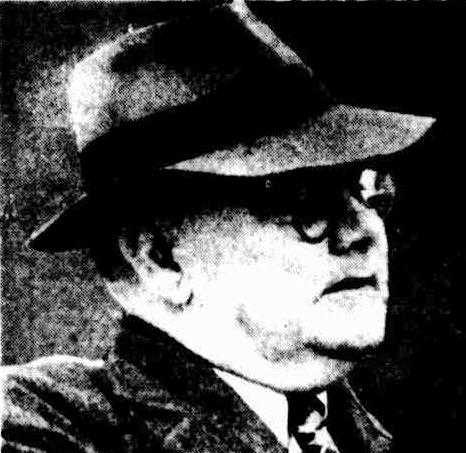 £50,000 gift to cancer fight
£50,000 gift to cancer fightSydney, Friday
Mr. E. J. HALLSTROM
Sydney philanthropist Mr, E. J. Hallstrom today offered £ 50,000 to the Royal Prince Alfred Hospital for the campaign against cancer.
He slid the sum was for a “general attack on the disease," to include research and clinical treatment. Dr Schlink, hospital chairman, said he was sure this "most generous offer” would be accepted by the board. Three years ago a Hallstrom heart clinic was established at the hospital
"A separate unit will be established, similar to the heart clinic, and the whole problem of cancer will be attacked," Dr. Schlink said
£20,000 already
The £50,000 is additional to £20,000 Mr. Hallstrom has already given for cancer treatment, including: the use of A.C.T.H. and anti-biotics
He said today that mice to be used for research were on their way from New York, and would be available early next month.
A committee on cancer research had been chosen Mr O'Sullivan, Minister for Health, said today. £50,000 gift to cancer fight (
1952, January 5).
The Argus(Melbourne, Vic. : 1848 - 1957), , p. 1. Retrieved from
http://nla.gov.au/nla.news-article23155641
In 1954 Dr. Schlink and the architect who had helped him in his endeavours to expand all the RPAH could do were recognised for their efforts:
THIRTEEN KNIGHTS IN NEW BIRTHDAY AWARDS
Queen Honors Judges, Scientist, Airman and Churchmen
Thirteen Australians, including three Victorians, have received knighthoods conferred by Queen Elizabeth in her Birthday honors Commonwealth List. The list names three High Court Judges, two of whom have 'been knighted previously and now receive higher orders of knighthood.
The Chief Justice of the High Court, Sir Owen Dixon — - already a Knight Commander of St. Michael and St. George — becomes Knight Grand Cross of St. Michael and St. George.-
The two other Victorians have been created Knights Bachelor- — Sir Ian Clunies-Ross, chairman of the C.S.I.R.O., and Sir Arthur George Stephenson, a distinguished architect.
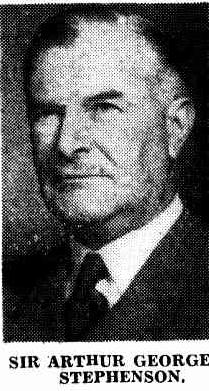 SIR ARTHUR GEORGE STEPHENSON, C.M.G., M.C., of Melbourne, in recognition of his outstanding contribution in raising the standards of architecture throughout Australia, and for his valuable assistance to the Commonwealth in the sphere of architectural design over a period of many years.Sir Ian Clunies-Ross had received the C.M.G. in the last New Year honors.
SIR ARTHUR GEORGE STEPHENSON, C.M.G., M.C., of Melbourne, in recognition of his outstanding contribution in raising the standards of architecture throughout Australia, and for his valuable assistance to the Commonwealth in the sphere of architectural design over a period of many years.Sir Ian Clunies-Ross had received the C.M.G. in the last New Year honors.
SIR HERBERT HENRY SCHLINK, of Sydney, in recognition of a most distinguished career both as a surgeon and as a citizen. His contributions to the treatment of cancer are world famous, and he has written a number of text books on gynaecology.
SIR PATRICK GORDON TAYLOR, G.C., M.C., of Sydney, in recognition of his outstanding pioneering services to Australian civil aviation.
NEW AID ON CANCER
Sydney now had methods of detection and cure of certain types of cancer in women that might be ahead of any other clinic in the world, Sir Herbert Schlink said today.
Sir Herbert, who is Royal Prince Alfred Hospital chairman, made this claim when, giving details today of new cancer detection apparatus installed at the hospital. He said this could result in cures for between 90 and 98 percent of cases of certain types of cancer in women, provided an early diagnosis were made, be also claimed that the death rate from this type of cancer was lower at Royal Prince Alfred Hospital than at any other clinic in Australia. He said that by early detection and a combination of radium and radical surgery the hospital had saved the lives of from eight to 10 more patients in every 100 than any other clinic in Australia. Sir Herbert said that a new cancer detection machine had been imported from Vienna The machine, called an Antoine electric colpomicroscope, could detect malignant cells below the surface, and magnify them 2000 times. NEW AID ON CANCER (
1954, July 8).
The Sun (Sydney, NSW : 1910 - 1954), , p. 21 (LATE FINAL EXTRA). Retrieved from
http://nla.gov.au/nla.news-article229713668
Cancer Detection
SYDNEY, Thurs. — A. new cancer detection apparatus at Royal Prince Alfred Hospital offers methods of curing certain types of cancer in women. The methods might be ahead of any other clinic in the world.
This claim was made today by Sir Herbert Schlink, chairman of the hospital, who said the new detection machine had been imported from Vienna six months ago. Sir Herbert said the new methods could result in cures for between 90 and 98 per cent of cases of certain types of cancer in women, provided an early diagnosis were made. Cancer Detection (
1954, July 9).
Daily Examiner (Grafton, NSW : 1915 - 1954), , p. 1. Retrieved from
http://nla.gov.au/nla.news-article192823966
BIG PARTIES TO BE HELD FOR B.M.A. CONGRESS
A round of social functions for the 2,000 visitors who will attend the Australasian Congress of the British Medical Association in Sydney next year is already being planned by a committee of more than 100 wives of Sydney doctors.
Groups have been formed to organise transport, sports, home entertainment, parties, and outings for the week of the congress, from August 20 to 27.
On the first night of the congress, Mrs. A. J. Collins, who is president of the women's committee, will give a cocktail party for 100 guests at her home at Killara, and Mrs. Frank Hansman will also entertain 100 visitors at her Vaucluse home.
Parties at Palm Beach on the Sunday of congress week are being planned by Sir. Herbert and Lady Schlink, Dr. and Mrs. S. N. Chanhall, and Dr. and Mrs. C. R. Laverty.
Other hostesses who will entertain at home are Mrs. A. H. Baldwin, Mrs. M. A. O'Halloran, Mrs. Stanley Goulston, and Mrs. Clive Robinson.
Six hostesses—Mesdames R. Black, Rod Macdonald, Richard Harris, Edgar Thom-son, Fred Niesche and R. B. Noad, will give a combined cocktail party at the Pickwick Club, and another group of eight, Mesdames Rex Money, Grant Lindeman, Victor Coppleson, John Belisario, A. W. Morrow, F. Chenhall, Cotter Harvey and George Stening, will entertain 200 guests for cocktails.
The biggest official functions will be the congress dinner at Mark Foys, and the ball. BIG PARTIES TO BE HELD FOR B.M.A. CONGRESS (
1954, August 10).
The Sydney Morning Herald (NSW : 1842 - 1954), , p. 13. Retrieved from
http://nla.gov.au/nla.news-article18432430
Care Of The Aged
How we can alleviate the social problem of our old and sick people was the main discussion at the United Hospital Auxiliaries 20th Annual conference, held in Sydney last week.
The 270 delegates who attended the three-day conference were acutely aware of the- urgent need for proper housing and medical care for the aged. Sir Herbert Schlink, chairman of the Royal Prince Alfred Hospital, who officially opened the conference said, 'Since attending overseas conferences, I believe that we in Australia are lagging behind in the question of the care of old, sick people. We seem to have forgotten what we owe to the old who made our cities. 'It is not only homes that are needed for the old,' he continued, 'but care of the sick, which is most important. When I attended the Brussels conference, I noticed that around the hospital centre were built houses for the old sick people, so that the staff of the hospital could visit them in their homes. 'The aged were admitted to the homes for even minor complaints, and so they received prompt attention,' he added.
Sir Herbert Schlink fully supported a motion put forward by the Parkes branch that the government be urged to give serious and sympathetic consideration to the establishment of homes for aged people in city and country areas in the very near future. A Parkes representative reminded the conference that it is the old people who made Australia what it is today for us to enjoy.
Country Appeal
She asked all the women present to pledge that they would see their local State member and let him know that the women are alive to social problems. One of the guest speakers, Miss Katharine Ogilvie, who is a lecturer in medical social work at the Sydney University, appealed to people in country towns to start small, intimate homes for those with long chronic illnesses. 'What, happens to long term cases in country; hospitals?' Miss Ogilvie asked her audience. 'They are either kept indefinitely in the hospital, with no facilities for proper care, or moved out to make room for casualty cases. 'It would help if there was an increase in the number of small welfare homes run by churches and voluntary societies. 'Although there are undoubtedly some homes for the aged run for profit, there are also some Very wonderful women running private welfare homes,' she added. During her address, Miss Ogilvie supported a suggestion put forward by Sir Herbert Schlink earlier at the conference, that a community chest be established along American lines, to do away with perpetual canvassing and box rattling. Money collecting would then be concentrated on a certain section of the year. Miss Ogilvie commented that a community chest would .mean enhanced efficiency and save time and trouble. Home and Fashion (
1954, October 29).
The Farmer and Settler (Sydney, NSW : 1906 - 1955), , p. 21. Retrieved from
http://nla.gov.au/nla.news-article117083811
The above few insights into what Dr. Schlink was known to have achieved, wanted to see occur, and a few articles that he has written, make you wonder if this man ever took a day off. In 1962 he ended his 28 years as Chairman of Directors at the RPAH
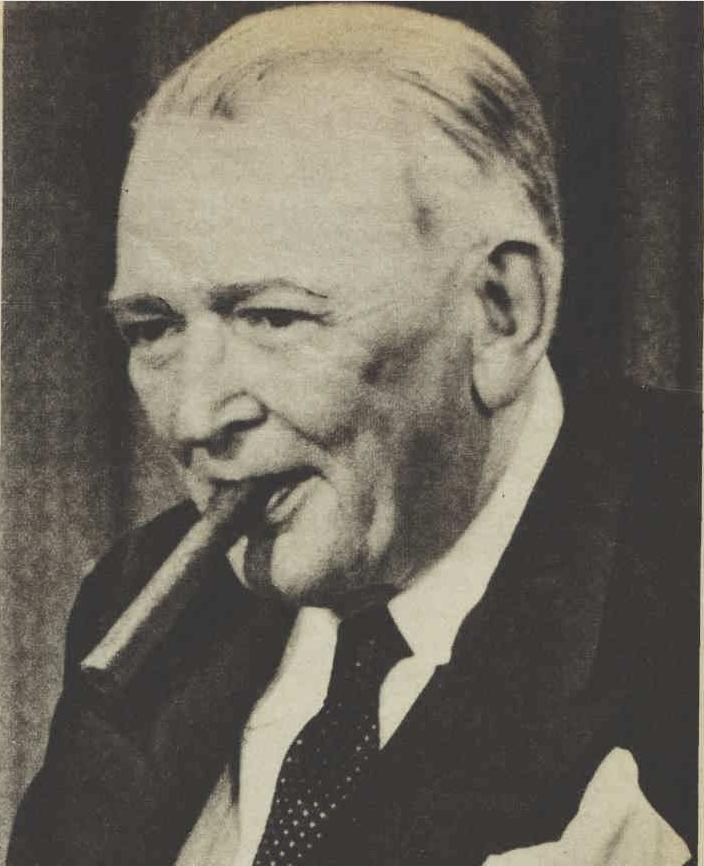
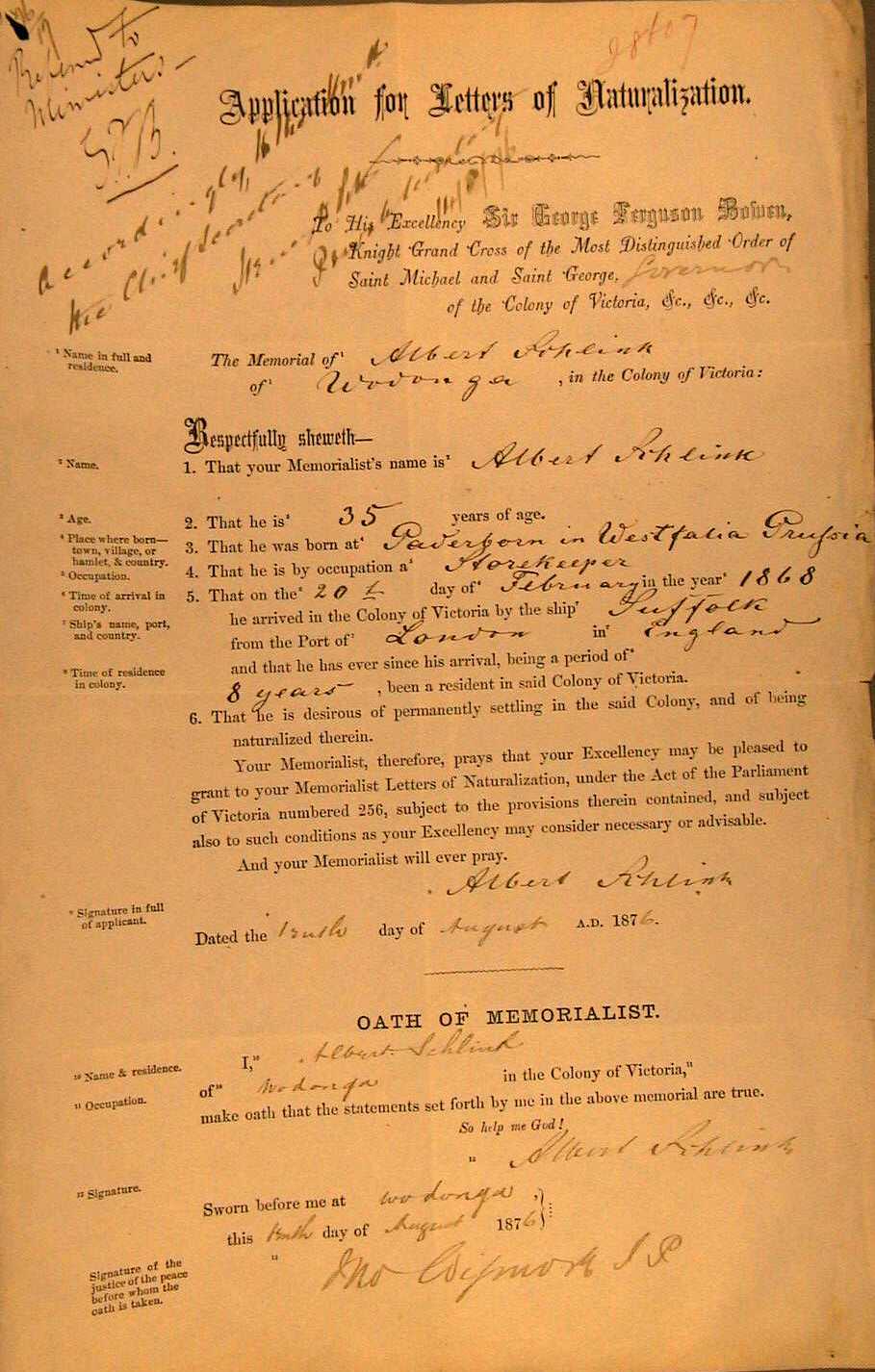

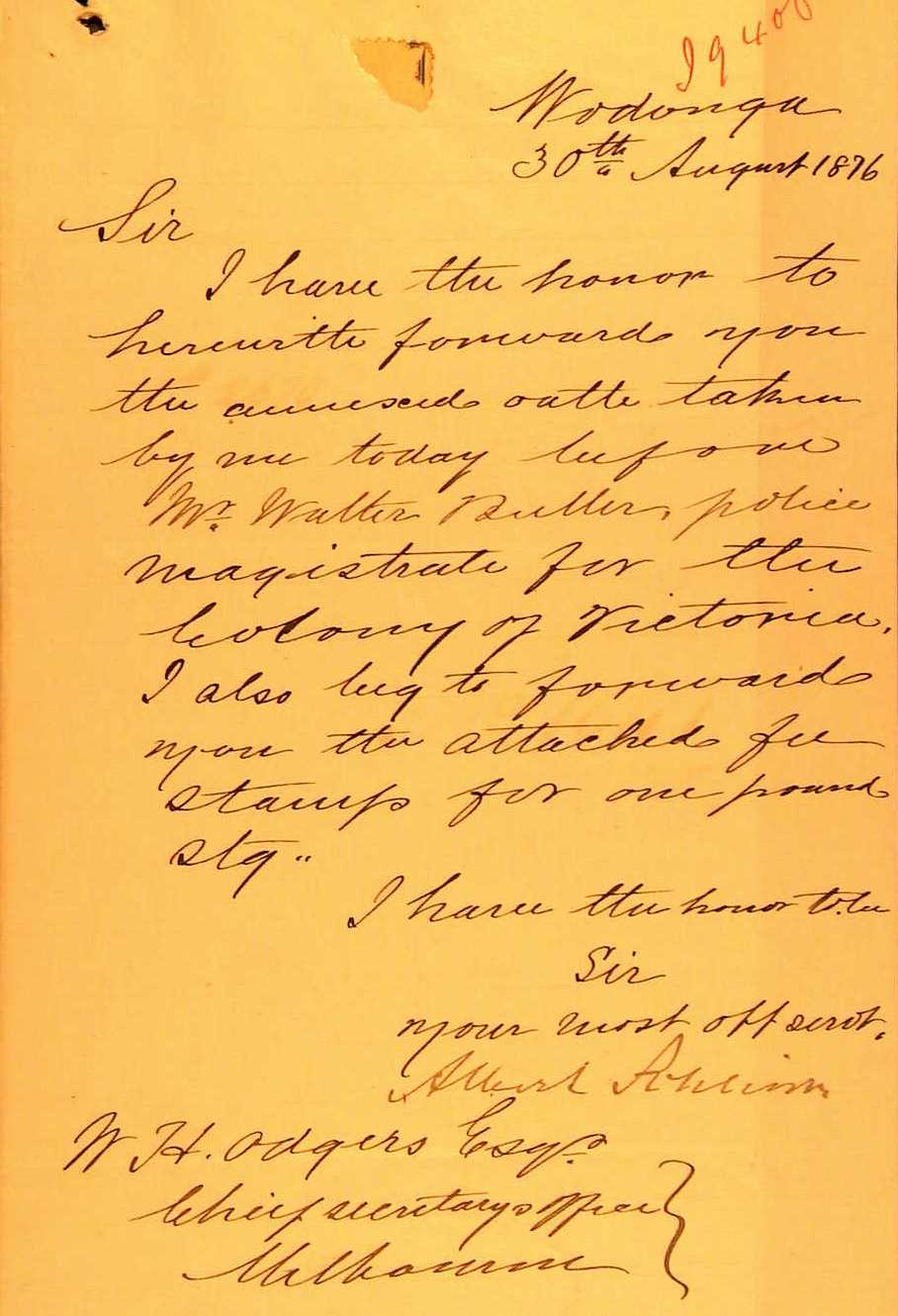
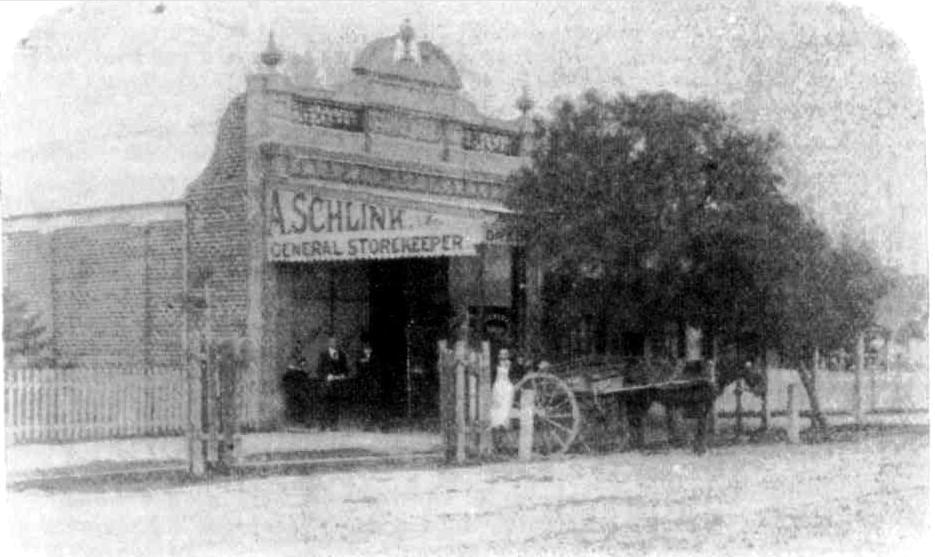
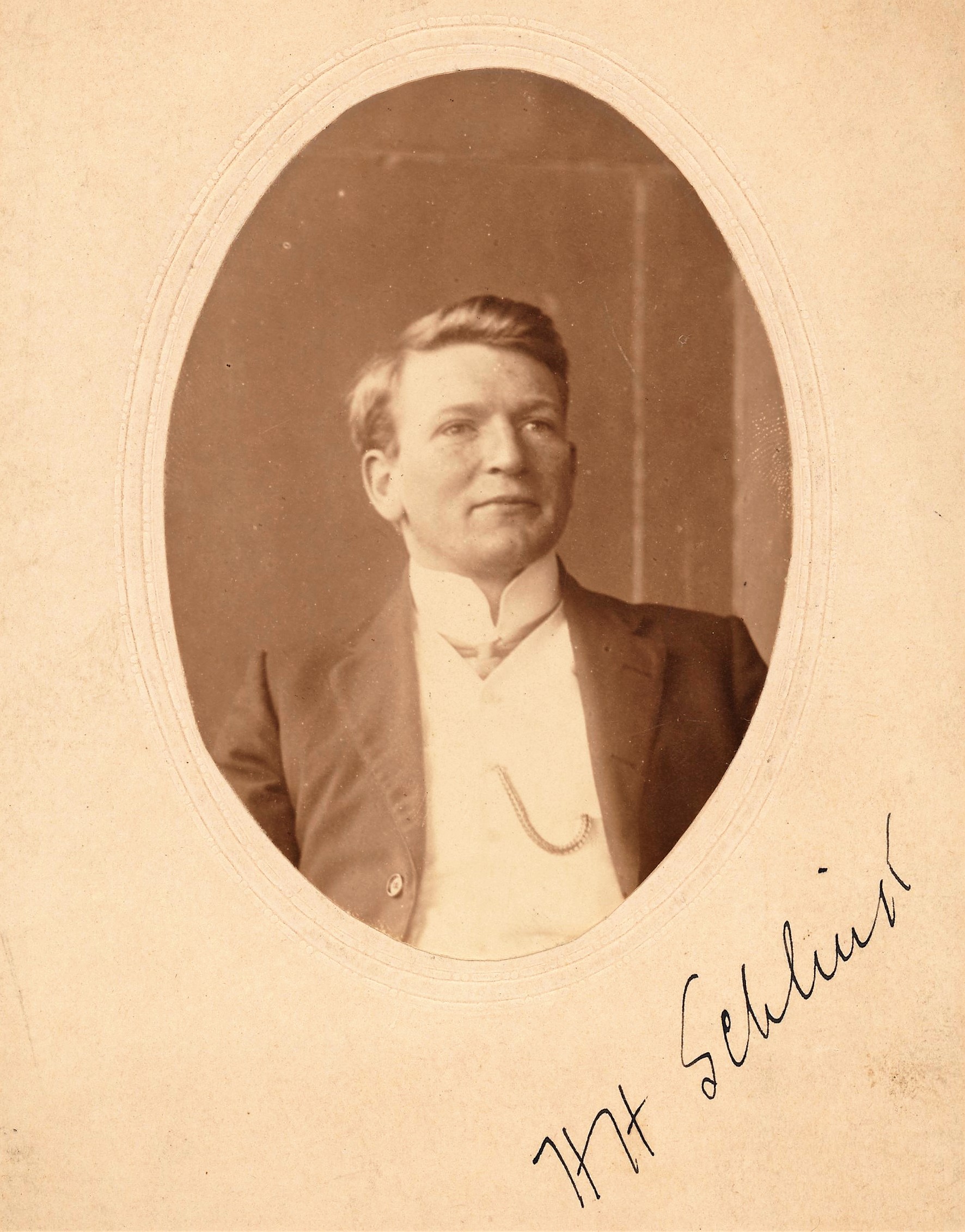
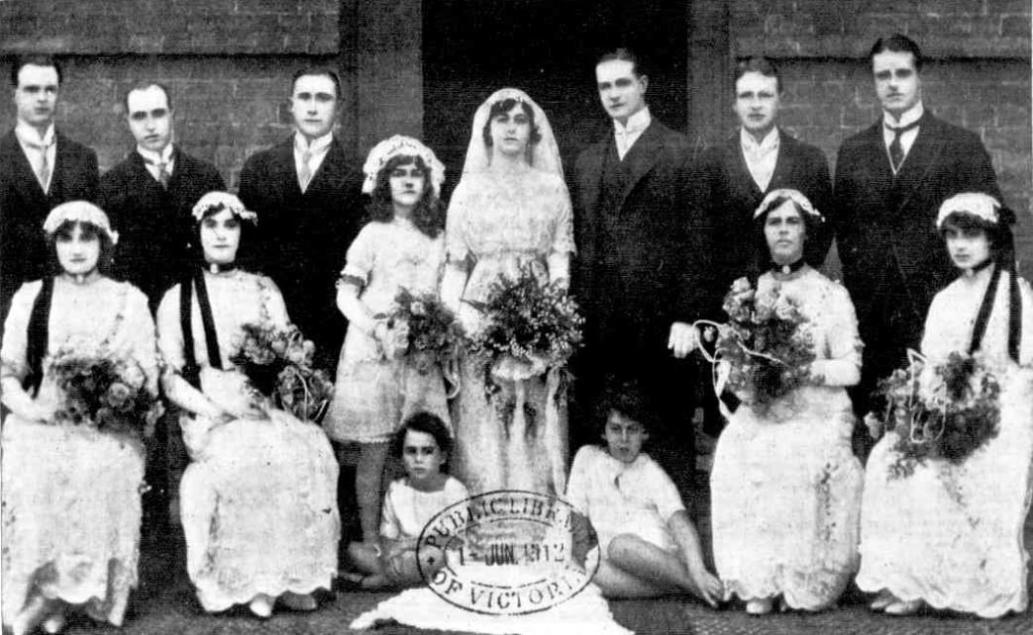
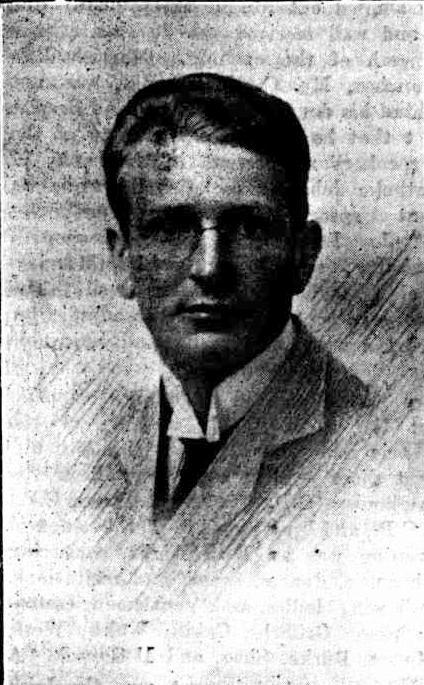

 Dr. Herbert Schlink spent a few days in Paris last week on his way through to London. Since his arrival in Europe some five months ago, Dr. Schlink has wandered as far afield as Constantinople, to reach which he went through some amusing, though trying, experiences as a result of the Orient express being snow-bound.
Dr. Herbert Schlink spent a few days in Paris last week on his way through to London. Since his arrival in Europe some five months ago, Dr. Schlink has wandered as far afield as Constantinople, to reach which he went through some amusing, though trying, experiences as a result of the Orient express being snow-bound.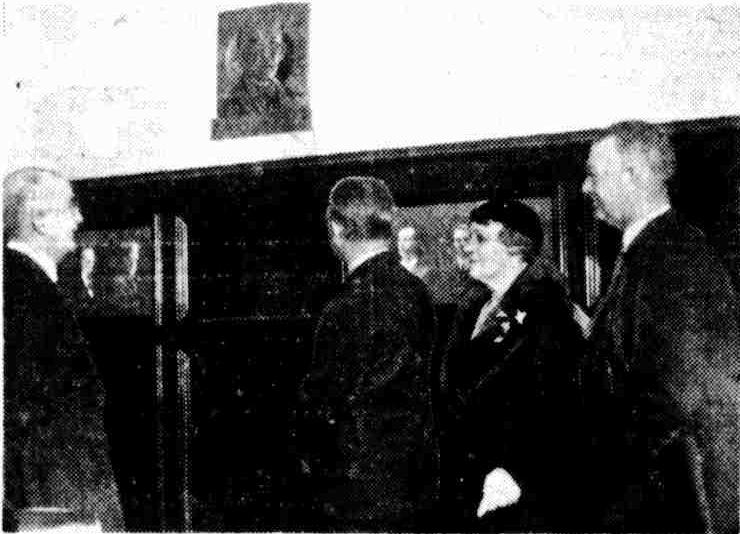
 MEDICAL CHIEF TO EXECUTIVE HEAD
MEDICAL CHIEF TO EXECUTIVE HEAD Dr. J, C. Windeyer, professor of Obstetrics at Sydney University, also claimed that the proposed block for midwifery was unnecessary. The Jubilee fund should be devoted to post-graduate training and research work. There were already sufficient beds for teaching students at the Crown-street Hospital and the Royal Hospital for Women. Dr. Constance E. D'Arcy reaffirmed the view, expressed in her Anne MacKenzie oration, that a large modern maternity hospital should be built near the University. Sydney's midwifery hospitals and the University were too far apart. Mrs. Jessie M. Street (president of the United Associations) : "A large part of the Jubilee fund should be spent upon creating new health centres throughout the State. Sydney urgently requires another 20 of them. We think that essential social services should be considered before money is spent upon a new hospital." MATERNITY BLOCK WILL BE BUILT (1935, November 3). The Sun (Sydney, NSW : 1910 - 1954), , p. 7. Retrieved fromhttp://nla.gov.au/nla.news-article230180691
Dr. J, C. Windeyer, professor of Obstetrics at Sydney University, also claimed that the proposed block for midwifery was unnecessary. The Jubilee fund should be devoted to post-graduate training and research work. There were already sufficient beds for teaching students at the Crown-street Hospital and the Royal Hospital for Women. Dr. Constance E. D'Arcy reaffirmed the view, expressed in her Anne MacKenzie oration, that a large modern maternity hospital should be built near the University. Sydney's midwifery hospitals and the University were too far apart. Mrs. Jessie M. Street (president of the United Associations) : "A large part of the Jubilee fund should be spent upon creating new health centres throughout the State. Sydney urgently requires another 20 of them. We think that essential social services should be considered before money is spent upon a new hospital." MATERNITY BLOCK WILL BE BUILT (1935, November 3). The Sun (Sydney, NSW : 1910 - 1954), , p. 7. Retrieved fromhttp://nla.gov.au/nla.news-article230180691 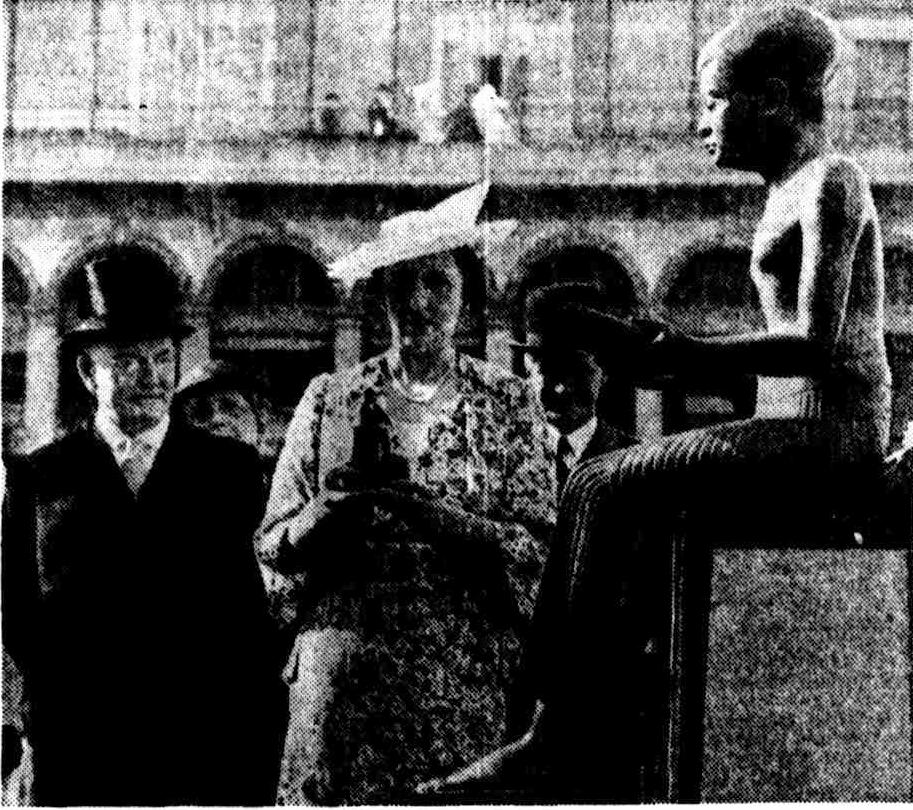
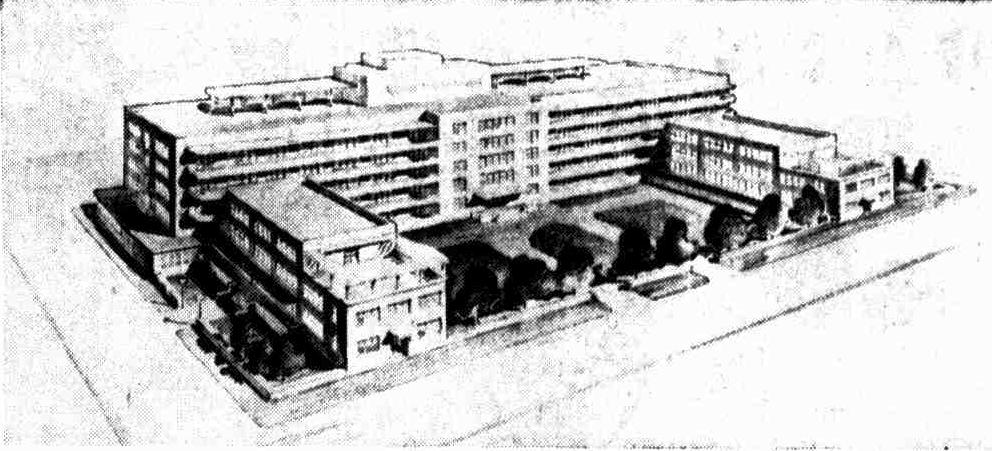

 Sir William Dixson (18 April 1870 – 17 August 1952) was an Australian businessman, collector and benefactor who bequeathed his collection of over 20,000 items of Australiana to the State Library of New South Wales, forming the Dixson Library.
Sir William Dixson (18 April 1870 – 17 August 1952) was an Australian businessman, collector and benefactor who bequeathed his collection of over 20,000 items of Australiana to the State Library of New South Wales, forming the Dixson Library. 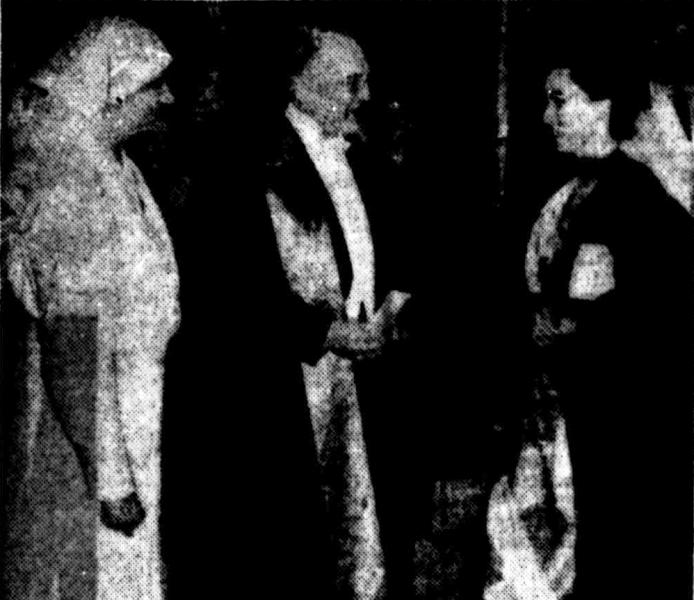
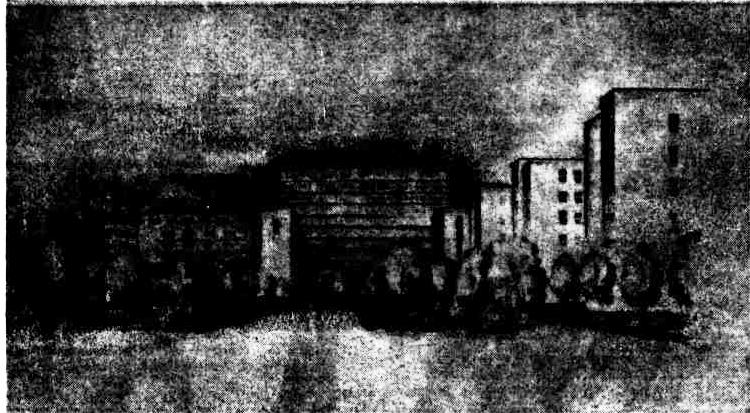
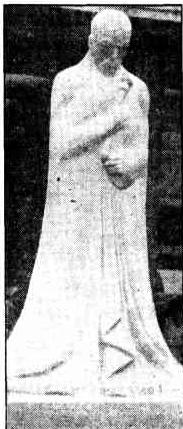
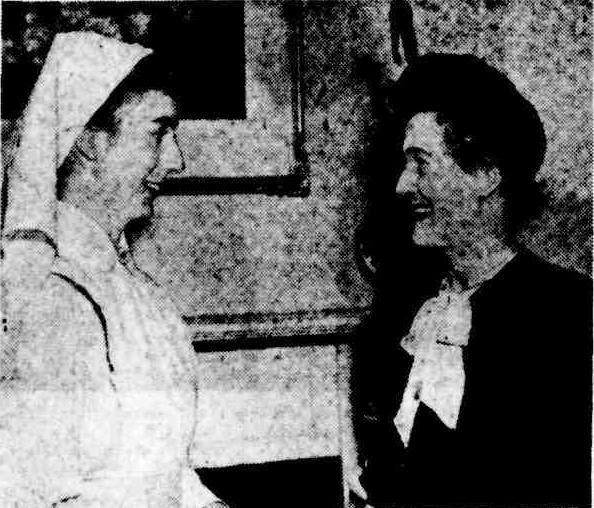
 £50,000 gift to cancer fight
£50,000 gift to cancer fight SIR ARTHUR GEORGE STEPHENSON, C.M.G., M.C., of Melbourne, in recognition of his outstanding contribution in raising the standards of architecture throughout Australia, and for his valuable assistance to the Commonwealth in the sphere of architectural design over a period of many years.Sir Ian Clunies-Ross had received the C.M.G. in the last New Year honors.
SIR ARTHUR GEORGE STEPHENSON, C.M.G., M.C., of Melbourne, in recognition of his outstanding contribution in raising the standards of architecture throughout Australia, and for his valuable assistance to the Commonwealth in the sphere of architectural design over a period of many years.Sir Ian Clunies-Ross had received the C.M.G. in the last New Year honors. 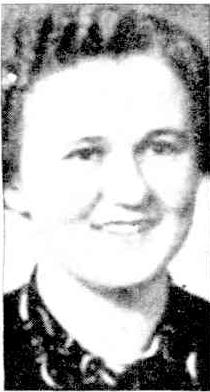 DR. H. H. SCHLINK TO MARRY DR. M. MULVEY
DR. H. H. SCHLINK TO MARRY DR. M. MULVEY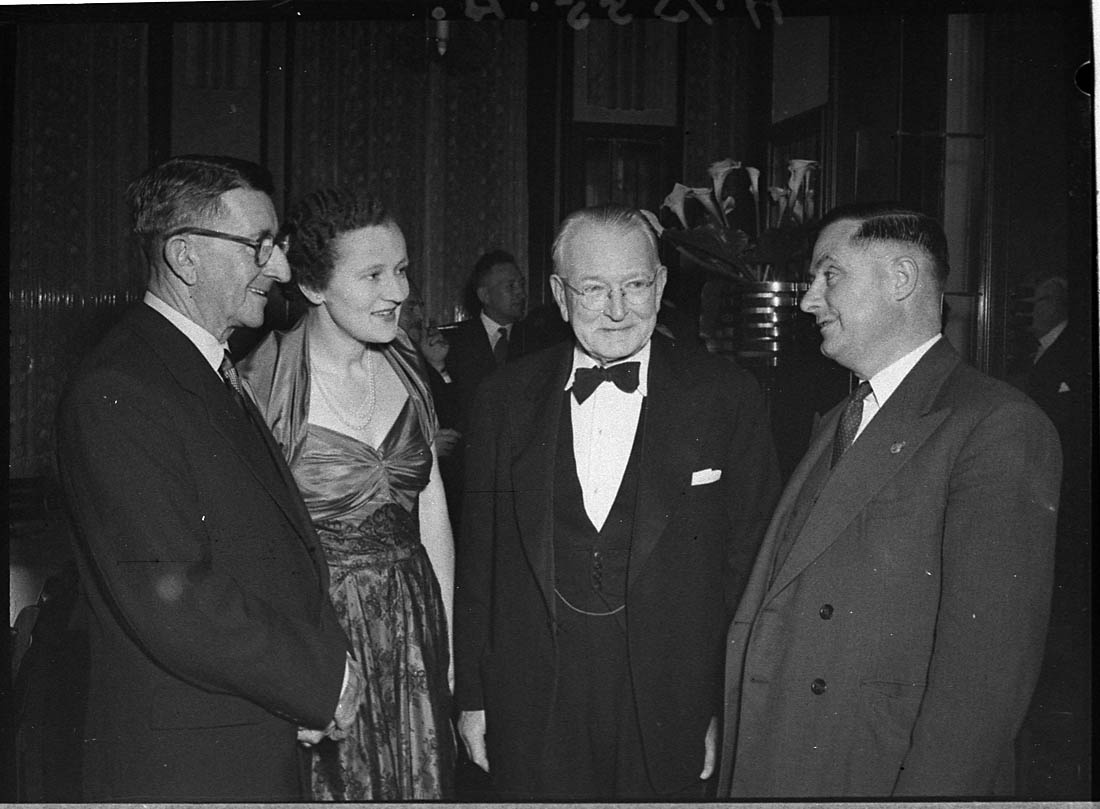
.jpg?timestamp=1591354015225)
.jpg?timestamp=1591353851956)
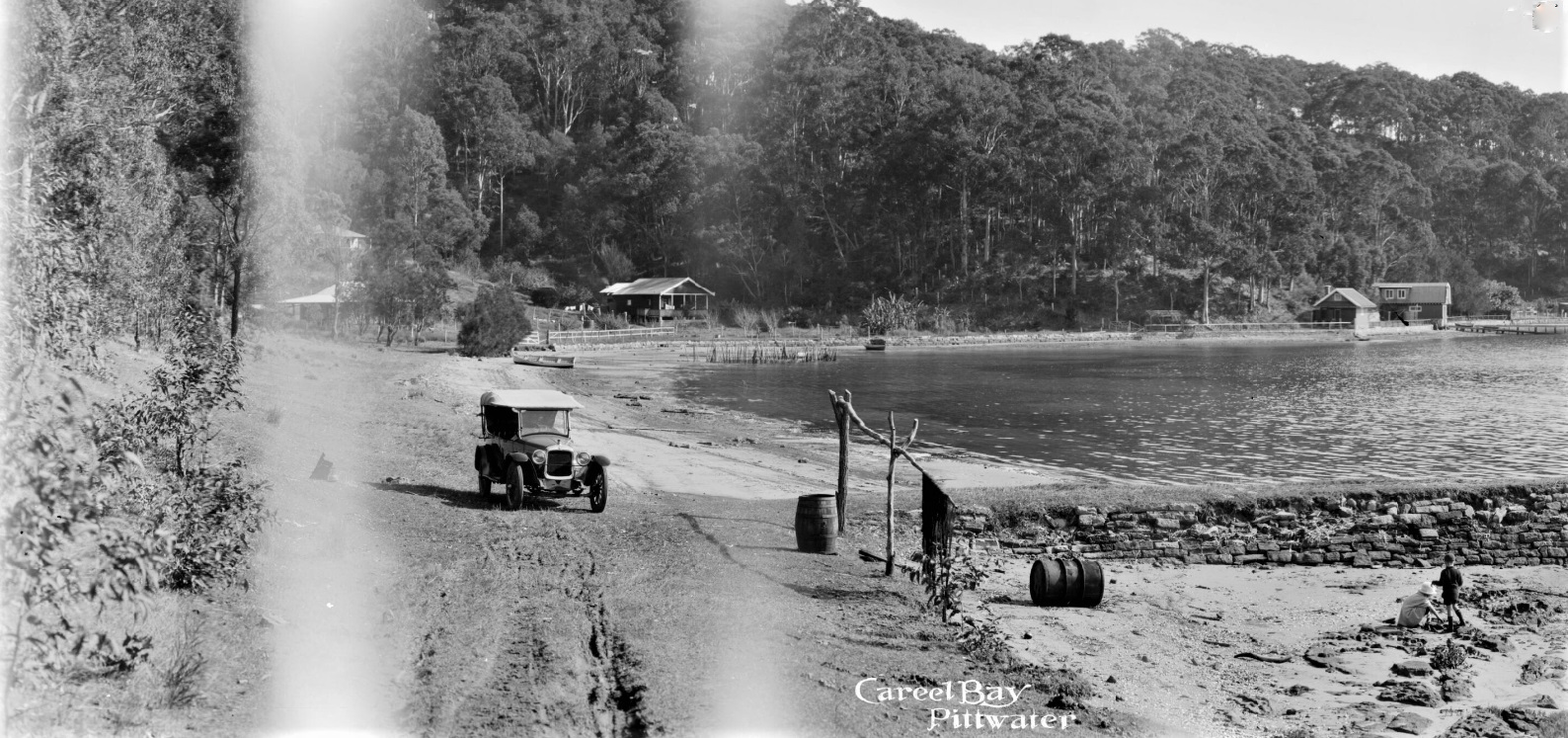
.jpg?timestamp=1591353917461)
.jpg?timestamp=1591353943667)
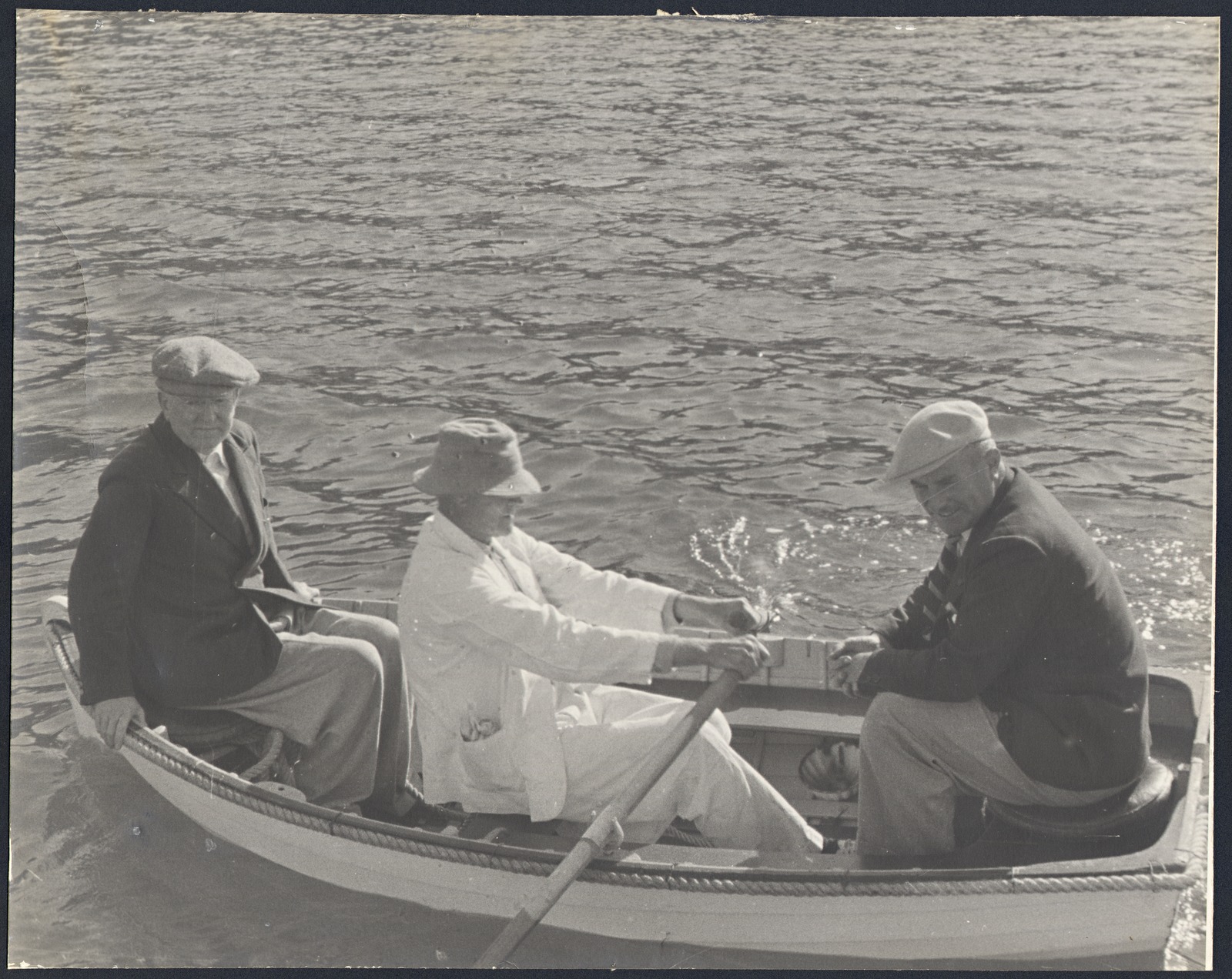
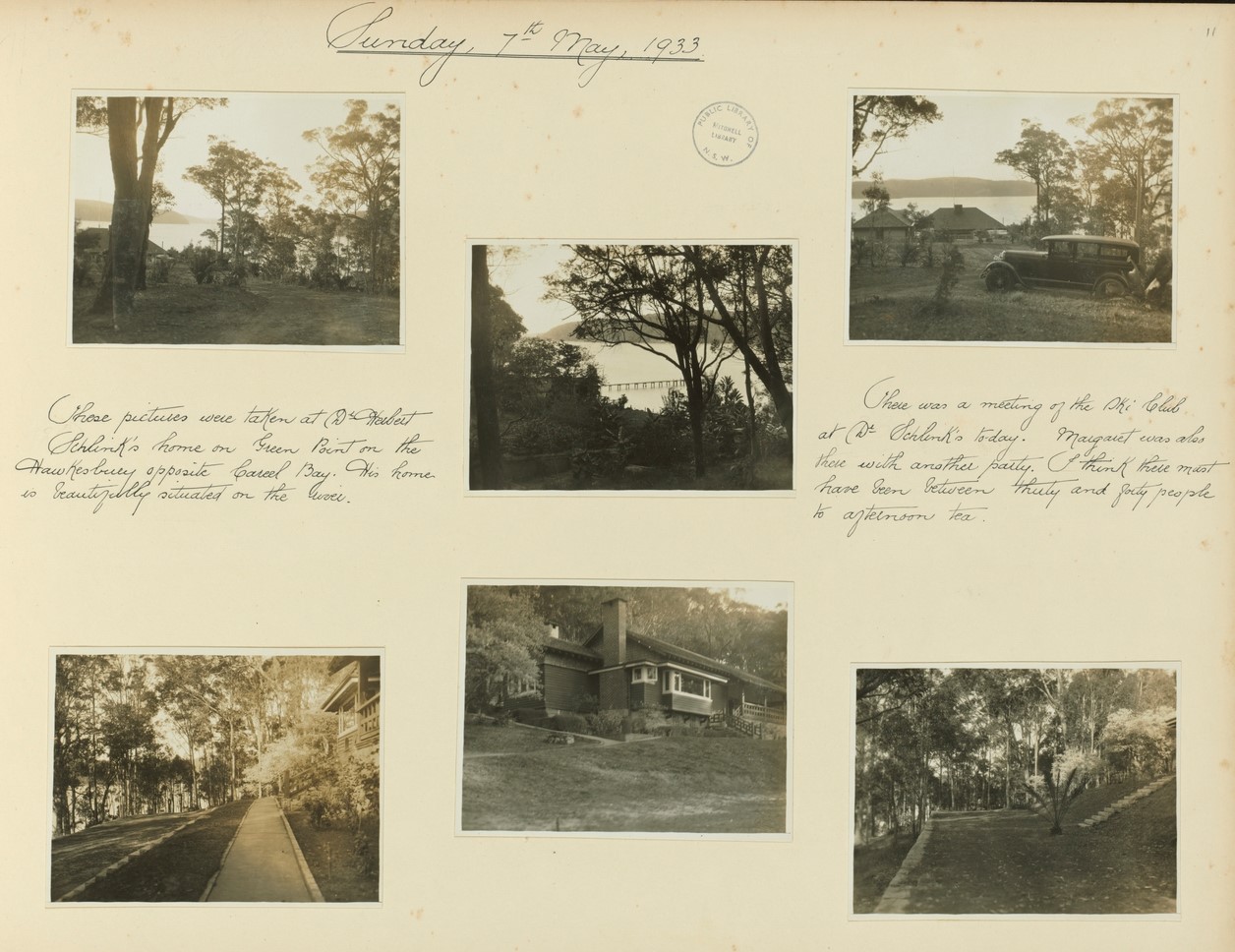
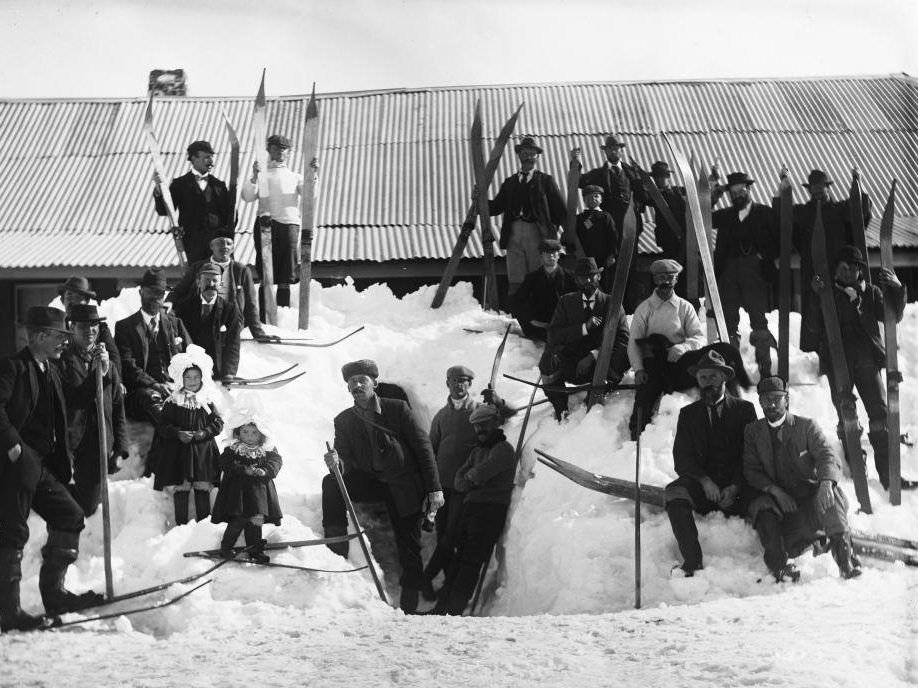
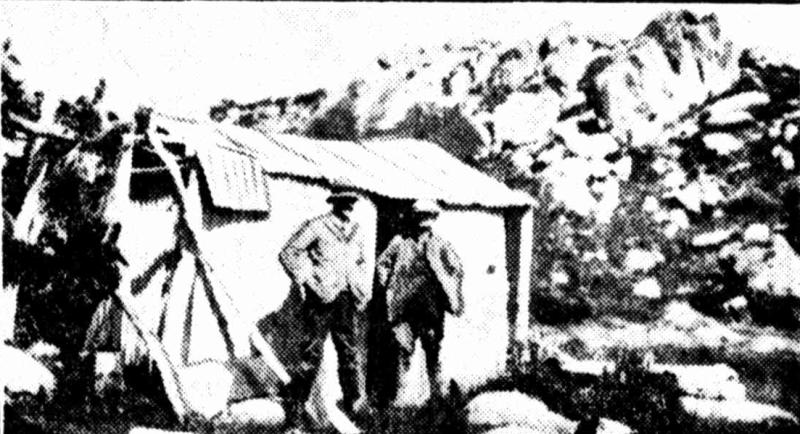
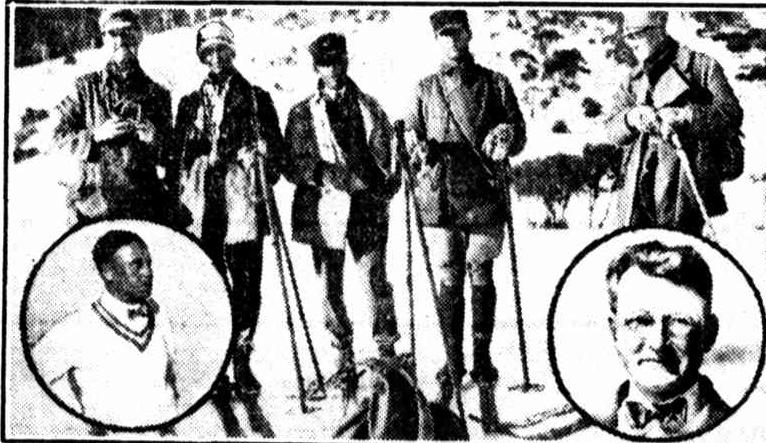
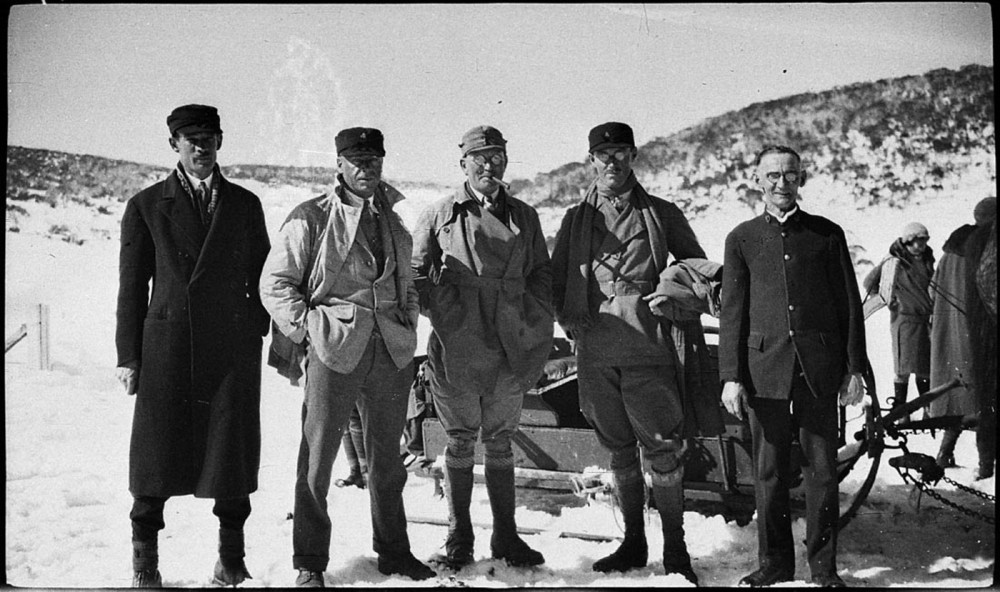
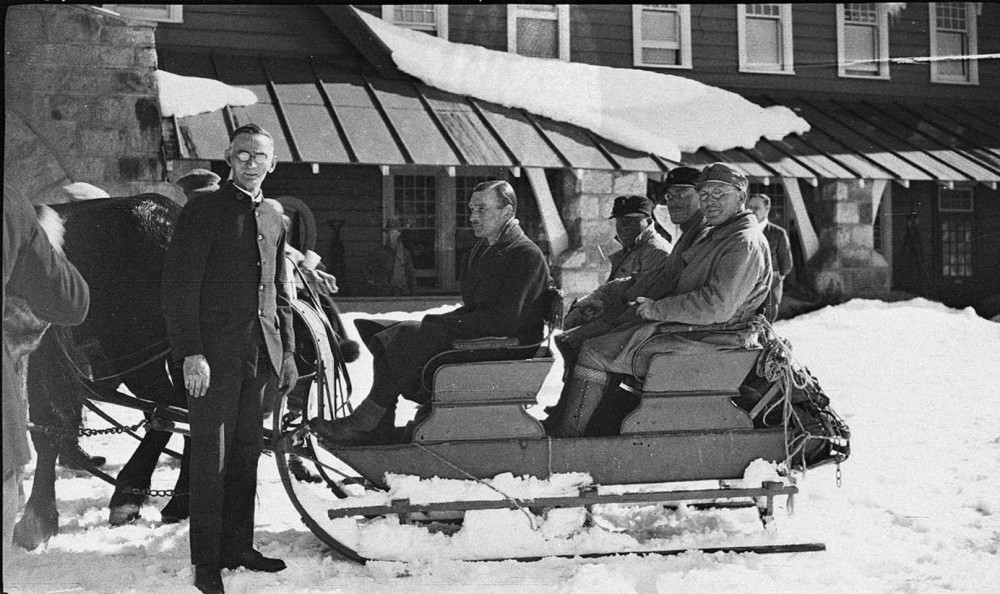
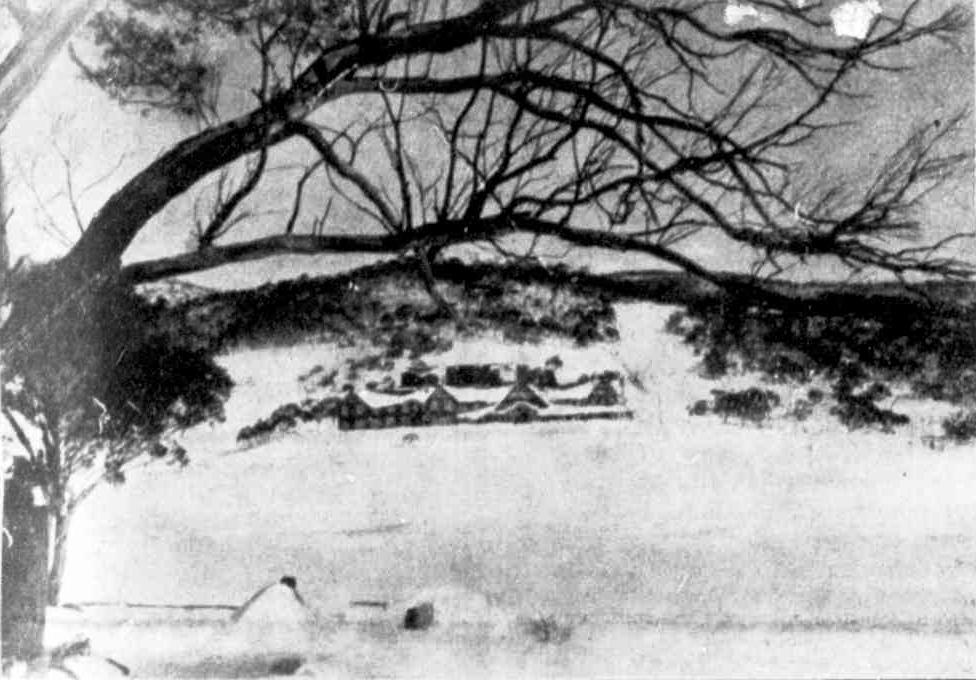
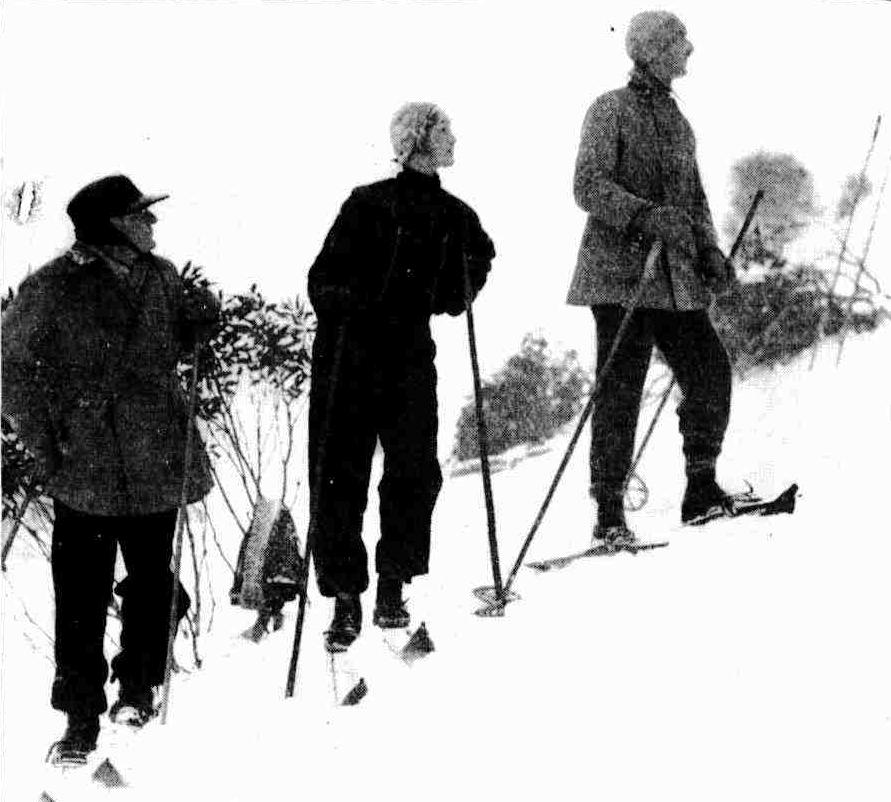
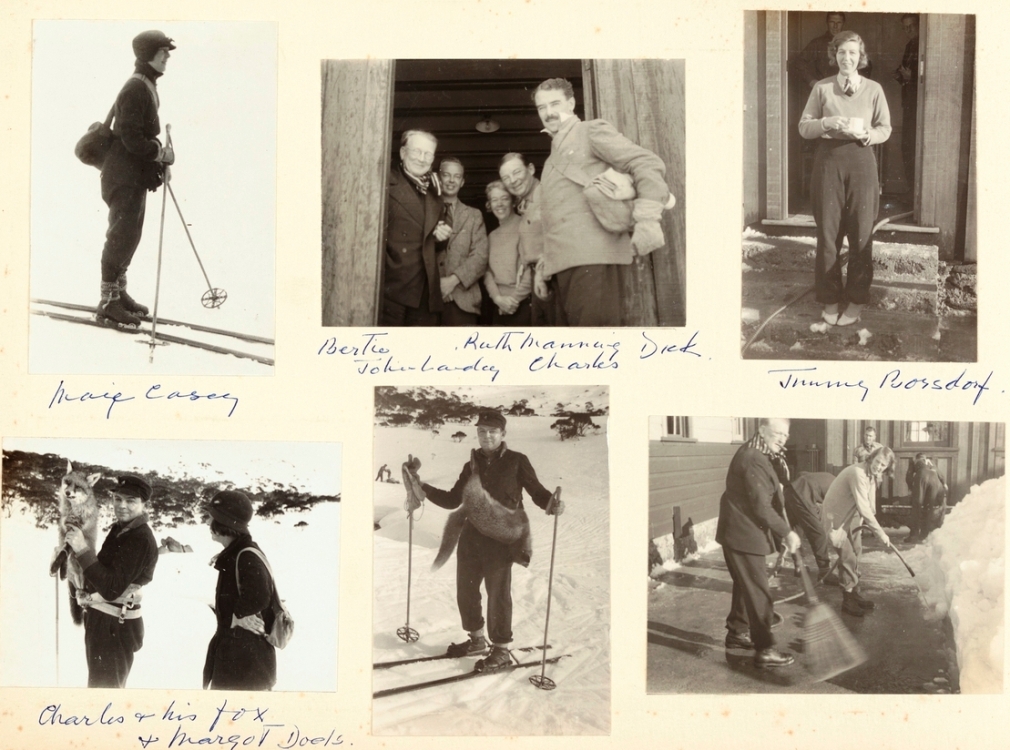
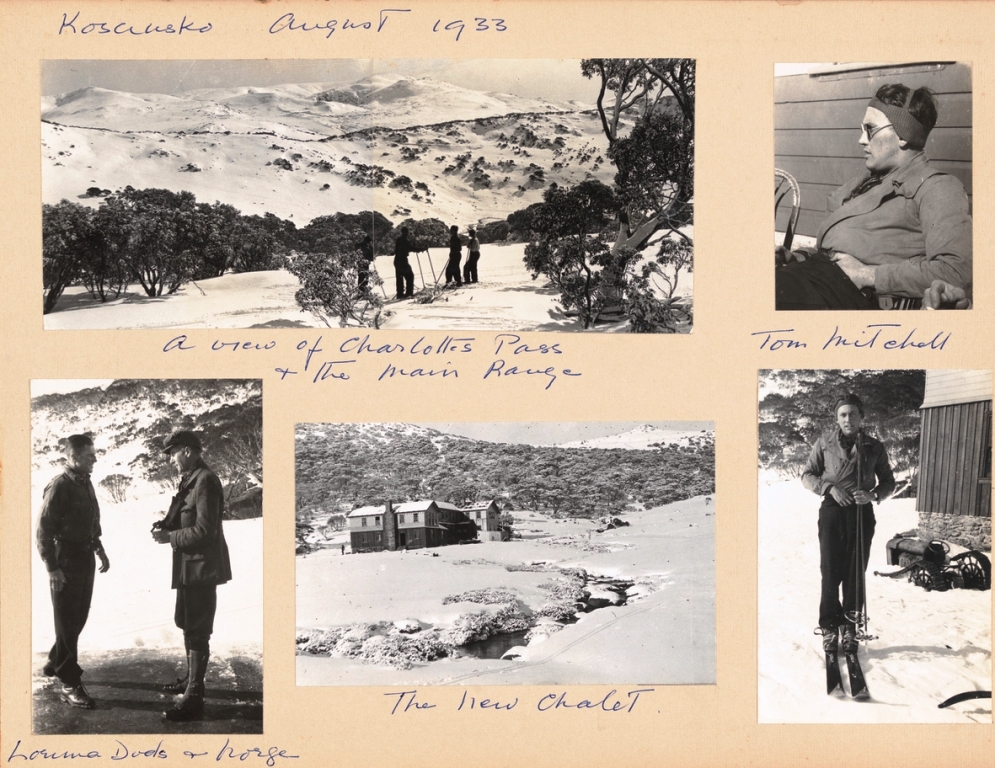
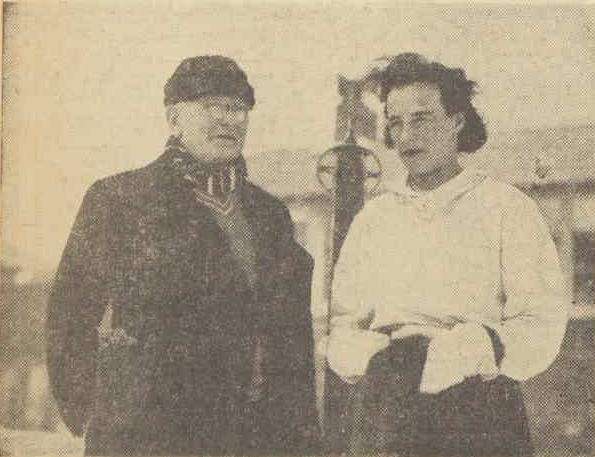 DR. AND MRS. BERTIE SCHLINK, who have been holidaying at Kosciusko and revelling in winter sports, are expected back any tick of the clock. Dr. Schlink and his wife are expert skiers. THE JOTTINGS OF A LADY ABOUT TOWN (1947, July 20). Truth(Sydney, NSW : 1894 - 1954), , p. 56. Retrieved from http://nla.gov.au/nla.news-article168784741
DR. AND MRS. BERTIE SCHLINK, who have been holidaying at Kosciusko and revelling in winter sports, are expected back any tick of the clock. Dr. Schlink and his wife are expert skiers. THE JOTTINGS OF A LADY ABOUT TOWN (1947, July 20). Truth(Sydney, NSW : 1894 - 1954), , p. 56. Retrieved from http://nla.gov.au/nla.news-article168784741 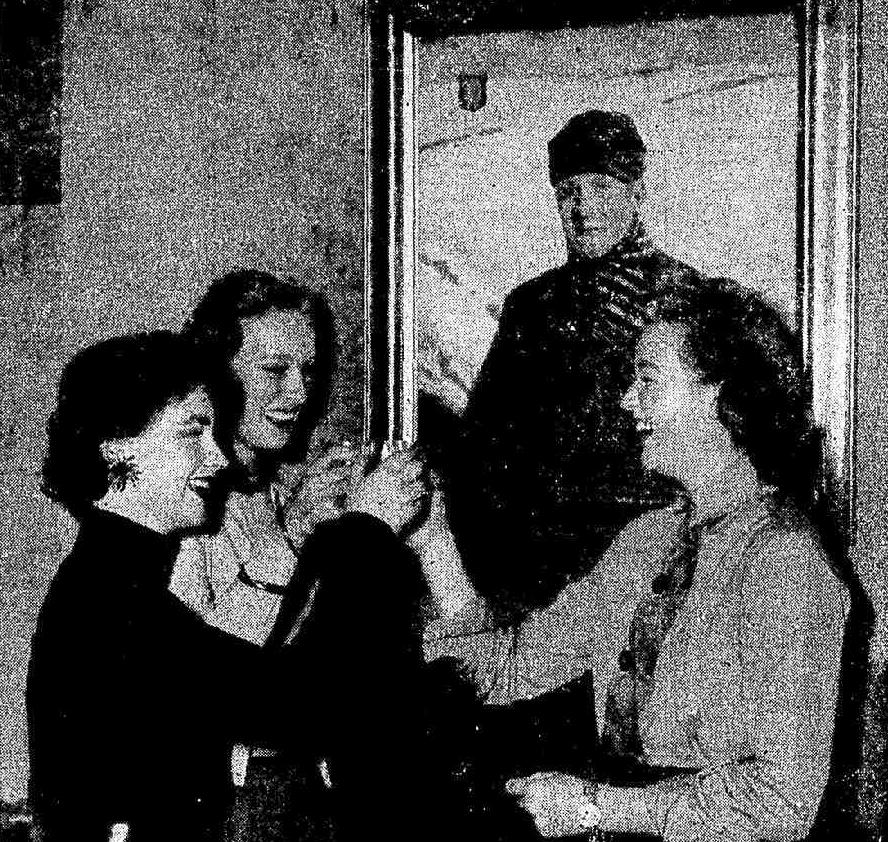
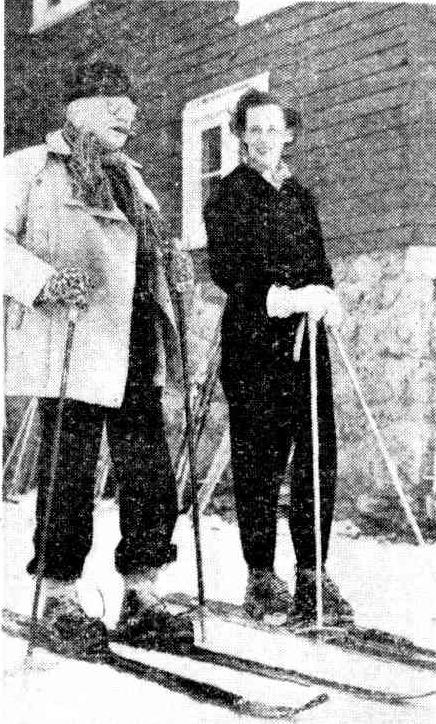 Sir Herbert Schlink, chairman of board of directors of the R.P.A. Hospital and president and founder of the Ski Club of Australia, with women's president, Mrs. Ashley Davey,outside the Ski Club of Australia rooms at the Chalet.
Sir Herbert Schlink, chairman of board of directors of the R.P.A. Hospital and president and founder of the Ski Club of Australia, with women's president, Mrs. Ashley Davey,outside the Ski Club of Australia rooms at the Chalet. 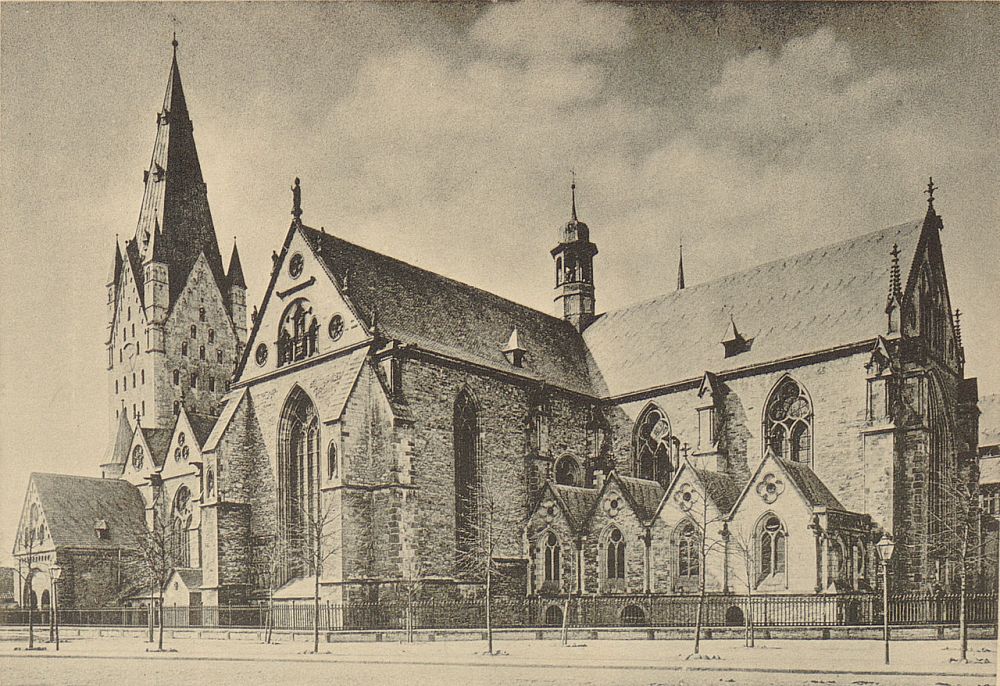
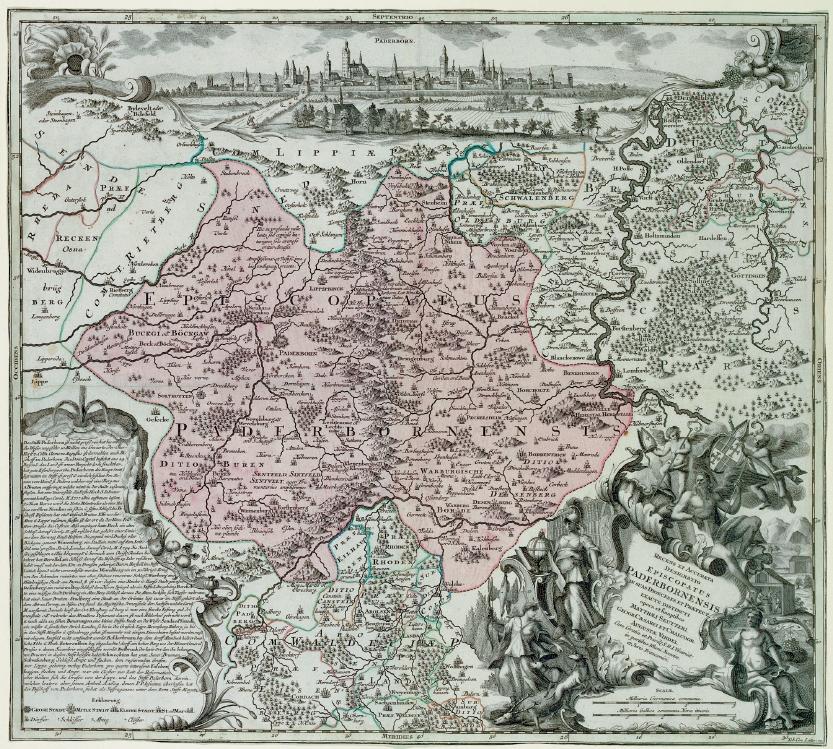
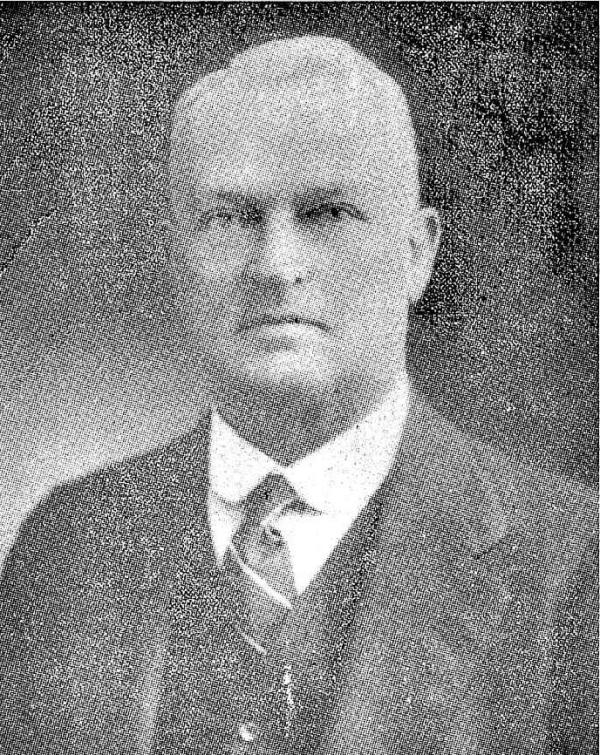 DEATH OF DR. R. H. SCHLINK - BORDER PRACTITIONER FOR 40 YEARS
DEATH OF DR. R. H. SCHLINK - BORDER PRACTITIONER FOR 40 YEARS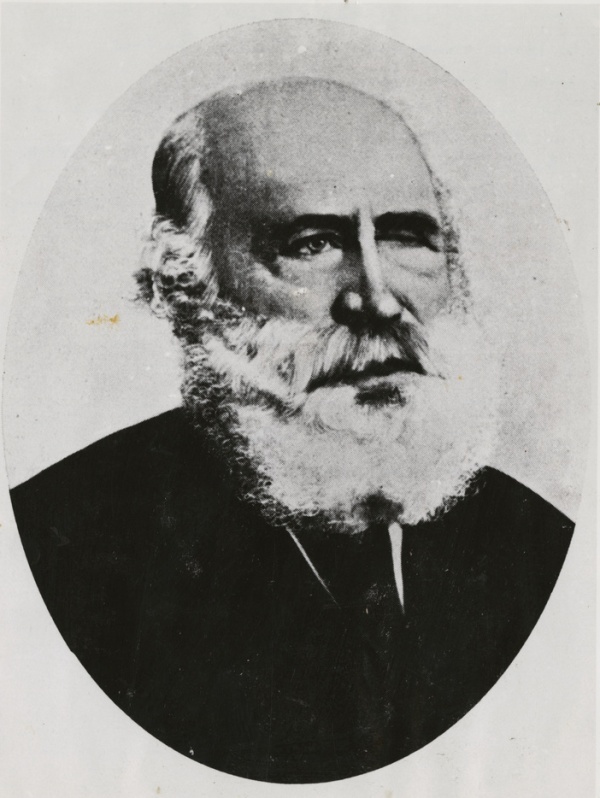 Mr. Schlink was not the first man to engage in pastoral operations on Flinders Island, although he did much to develop the place. The "South Australian" of August 22, 1845, records that the Messrs. Lechmere. and others were removing stock from Thistle; Island to Flinders Island, "a very pleasant place, with good grass, wood and water." The same paper mentioned that the people of the "Falco," lately wrecked, were at the same island, trying to build another vessel. These settlers left behind them pigs whose progeny had become wild. One ferocious boar, with' well developed tusks, gave Mr. Schlink a lot of trouble by killing and maiming his stock, and was eventually captured by natives. There was also a curious species of black and white rabbit which used little burrows when breeding, but otherwise lived entirely on the surface. Mr. Schlink proved Flinders Island to be an excellent grazing proposition, and he maintained a flock of 7,000 merinos. Isolation was the principal drawback. It was very difficult to get workers to remain there owing to the loneliness of the conditions, and a good deal of reliance had to be placed on the, services of the blacks. When it was desired that a vessel should call a big signal fire was lit on a prominent headland called Bob's Nose, so named- from the circumstance that the first horse Mr. Schlink had was dubbed Bob, and he used to stand habitually on this headland. The animal lived for 36 years, and then met death by falling down a well.
Mr. Schlink was not the first man to engage in pastoral operations on Flinders Island, although he did much to develop the place. The "South Australian" of August 22, 1845, records that the Messrs. Lechmere. and others were removing stock from Thistle; Island to Flinders Island, "a very pleasant place, with good grass, wood and water." The same paper mentioned that the people of the "Falco," lately wrecked, were at the same island, trying to build another vessel. These settlers left behind them pigs whose progeny had become wild. One ferocious boar, with' well developed tusks, gave Mr. Schlink a lot of trouble by killing and maiming his stock, and was eventually captured by natives. There was also a curious species of black and white rabbit which used little burrows when breeding, but otherwise lived entirely on the surface. Mr. Schlink proved Flinders Island to be an excellent grazing proposition, and he maintained a flock of 7,000 merinos. Isolation was the principal drawback. It was very difficult to get workers to remain there owing to the loneliness of the conditions, and a good deal of reliance had to be placed on the, services of the blacks. When it was desired that a vessel should call a big signal fire was lit on a prominent headland called Bob's Nose, so named- from the circumstance that the first horse Mr. Schlink had was dubbed Bob, and he used to stand habitually on this headland. The animal lived for 36 years, and then met death by falling down a well. 